DENON DRA-201 User Manual [fr]
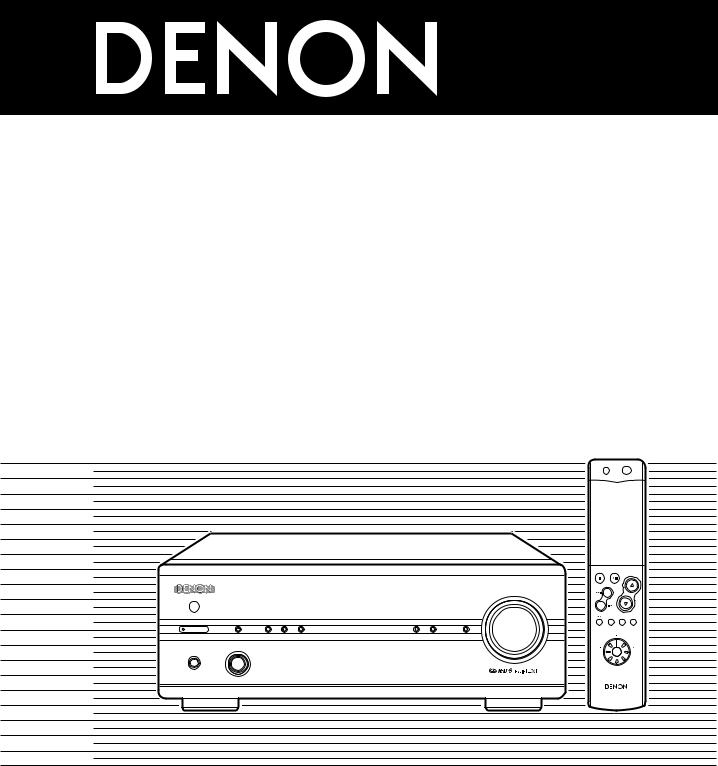
STEREO RECEIVER
DRA-201SA
OPERATING INSTRUCTIONS |
INSTRUCCIONES DE OPERACION |
||
BEDIENUNGSANLEITUNG |
GEBRUIKSAANWIJZING |
||
MODE D’EMPLOI |
BRUKSANVISNING |
||
ISTRUZIONI PER L’USO |
|
|
|
|
|
|
|
|
|
|
|
|
|
|
|
|
|
|
|
|
|
|
|
|
|
|
|
|
|
|
|
|
|
|
|
|
|
|
|
|
|
|
|
|
|
|
|
|
|
|
|
OFF |
ON |
SYSTEM
POWER
|
|
|
|
|
|
STOP |
PLAY VOLUME |
|
|
|
|
|
|
|
/SELECT |
|
|
|
|
|
|
PRESET |
|
|
|
|
|
|
|
VOLUME |
+ |
|
|
|
|
|
|
|
|
|
|
|
|
|
|
- |
|
ON / STANDBY |
MODE |
BAND MEMORY |
PRESET / TUNING |
SOURCE DIRECT |
TAPE |
|
|
TIMER / RDS |
/ SET |
DOWN UP |
|
SLEEP FUNCTION MODE |
|||
|
|
|
|
|
|
|
CD |
|
|
|
|
|
|
TUNER |
MD |
PHONES |
FUNCTION |
|
|
|
|
TAPE |
CD-R |
|
|
|
|
|
|
||
|
|
|
|
MHz |
CH |
|
|
|
|
TUNED |
STEREO |
AUTO |
|
|
|
|
|
|
|
|
|
STEREO RECEIVERER DRA-201SA |
|
RC-906
REMOTE CONTROL UNIT
FOR ENGLISH READERS |
PAGE |
004 |
~ PAGE |
020 |
FÜR DEUTSCHE LESER |
SEITE |
021 |
~ SEITE |
037 |
POUR LES LECTEURS FRANCAIS |
PAGE |
038 |
~ PAGE |
054 |
PER IL LETTORE ITALIANO |
PAGINA 055 |
~ PAGINA 071 |
||
PARA LECTORES DE ESPAÑOL |
PAGINA 072 |
~ PAGINA 088 |
||
VOOR NEDERLANDSTALIGE LEZERS |
PAGINA 089 |
~ PAGINA 105 |
||
FOR SVENSKA LÄSARE |
SIDA |
106 |
~ SIDA |
121 |
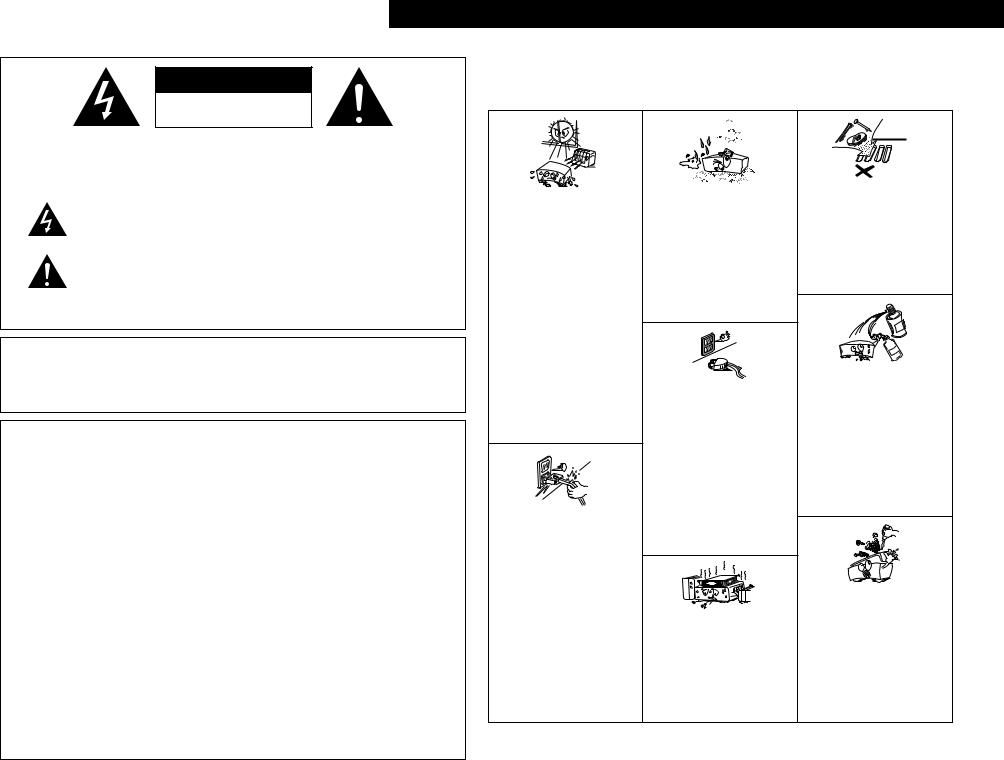
SVENSKA NEDERLANDS ESPAÑOL ITALIANO FRANCAIS DEUTSCH ENGLISH
CAUTION
RISK OF ELECTRIC SHOCK
DO NOT OPEN
CAUTION: TO REDUCE THE RISK OF ELECTRIC SHOCK, DO
NOT REMOVE COVER (OR BACK). NO USER
SERVICEABLE PARTS INSIDE. REFER SERVICING
TO QUALIFIED SERVICE PERSONNEL.
The lightning flash with arrowhead symbol, within an equilateral triangle, is intended to alert the user to the presence of uninsulated “dangerous voltage” within the product’s enclosure that may be of sufficient magnitude to constitute a risk of electric shock to persons.
The exclamation point within an equilateral triangle is intended to alert the user to the presence of important operating and maintenance (servicing) instructions in the literature accompanying the appliance.
WARNING: TO REDUCE THE RISK OF FIRE OR ELECTRIC SHOCK, DO NOT EXPOSE THIS APPLIANCE TO RAIN OR MOISTURE.
CAUTION
•The ventilation should not be impeded by covering the ventilation openings with items, such as newspapers, table-cloths, curtains, etc.
•No naked flame sources, such as lighted candles, should be placed on the apparatus.
•Please be care the environmental aspects of battery disposal.
•The apparatus shall not be exposed to dripping or splashing for use.
•No objects filled with liquids, such as vases, shall be placed on the apparatus.
•DECLARATION OF CONFORMITY
We declare under our sole responsibility that this product, to which this declaration relates, is in conformity with the following standards:
EN60065, EN55013, EN55020, EN61000-3-2 and EN61000-3-3.
Following the provisions of 73/23/EEC, 89/336/EEC and 93/68/EEC Directive.
•ÜBEREINSTIMMUNGSERKLÄRUNG
Wir erklären unter unserer Verantwortung, daß dieses Produkt, auf das sich diese Erklärung bezieht, den folgenden Standards entspricht:
EN60065, EN55013, EN55020, EN61000-3-2 und EN61000-3-3.
Entspricht den Verordnungen der Direktive 73/23/EEC, 89/336/EEC und 93/68/EEC.
•DECLARATION DE CONFORMITE
Nous déclarons sous notre seule responsabilité que l’appareil, auquel se réfère cette déclaration, est conforme aux standards suivants:
EN60065, EN55013, EN55020, EN61000-3-2 et EN61000-3-3.
D’après les dispositions de la Directive 73/23/EEC, 89/336/EEC et 93/68/EEC.
•DICHIARAZIONE DI CONFORMITÀ
Dichiariamo con piena responsabilità che questo prodotto, al quale la nostra dichiarazione si riferisce, è conforme alle seguenti normative:
EN60065, EN55013, EN55020, EN61000-3-2 e EN61000-3-3.
In conformità con le condizioni delle direttive 73/23/EEC, 89/336/EEC e 93/68/EEC.
QUESTO PRODOTTO E’ CONFORME AL D.M. 28/08/95 N. 548
•DECLARACIÓN DE CONFORMIDAD
Declaramos bajo nuestra exclusiva responsabilidad que este producto al que hace referencia esta declaración, está conforme con los siguientes estándares:
EN60065, EN55013, EN55020, EN61000-3-2 y EN61000- 3-3.
Siguiendo las provisiones de las Directivas 73/23/EEC, 89/336/EEC y 93/68/EEC.
•EENVORMIGHEIDSVERKLARING
Wij verklaren uitsluitend op onze verantwoordelijkheid dat dit produkt, waarop deze verklaring betrekking heeft, in overeenstemming is met de volgende normen:
EN60065, EN55013, EN55020, EN61000-3-2 en EN61000-3-3.
Volgens de bepalingen van de Richtlijnen 73/23/EEC, 89/336/EEC en 93/68/EEC.
•ÖVERENSSTÄMMELSESINTYG
Härmed intygas helt på eget ansvar att denna produkt, vilken detta intyg avser, uppfyller följande standarder: EN60065, EN55013, EN55020, EN61000-3-2 och EN61000-3-3.
Enligt stadgarna i direktiv 73/23/EEC, 89/336/EEC och 93/68/EEC.
NOTE ON USE / HINWEISE ZUM GEBRAUCH /
OBSERVATIONS RELATIVES A L’UTILISATION / NOTE SULL’USO NOTAS SOBRE EL USO / ALVORENS TE GEBRUIKEN / OBSERVERA
•Avoid high temperatures.
Allow for sufficient heat dispersion when installed on a rack.
•Vermeiden Sie hohe Temperaturen. Beachten Sie, daß eine ausreichend Luftzirkulation gewährleistet wird, wenn das Gerät auf ein Regal gestellt wird.
•Eviter des températures élevées
Tenir compte d’une dispersion de chaleur suffisante lors de l’installation sur une étagère.
•Evitate di esporre l’unità a temperature alte. Assicuratevi che ci sia un’adeguata dispersione del calore quando installate l’unità in un mobile per componenti audio.
•Evite altas temperaturas
Permite la suficiente dispersión del calor cuando está instalado en la consola.
•Vermijd hoge temperaturen.
Zorg voor een degelijk hitteafvoer indien het apparaat op een rek wordt geplaatst.
•Undvik höga temperaturer.
Se till att det finns möjlighet till god värmeavledning vid montering i ett rack.
•Handle the power cord carefully.
Hold the plug when unplugging the cord.
•Gehen Sie vorsichtig mit dem Netzkabel um. Halten Sie das Kabel am Stecker, wenn Sie den Stecker herausziehen.
•Manipuler le cordon d’alimentation avec précaution.
Tenir la prise lors du débranchement du cordon.
•Manneggiate il filo di alimentazione con cura.
Agite per la spina quando scollegate il cavo dalla presa.
•Maneje el cordón de energía con cuidado. Sostenga el enchufe cuando desconecte el cordón de energía.
•Hanteer het netsnoer voorzichtig.
Houd het snoer bij de stekker vast wanneer deze moet worden aanof losgekoppeld.
•Hantera nätkabeln varsamt.
Håll i kabeln när den kopplas från el-uttaget.
•Keep the set free from moisture, water, and dust.
•Halten Sie das Gerät von Feuchtigkeit, Wasser und Staub fern.
•Protéger l’appareil contre l’humidité, l’eau et lapoussière.
•Tenete l’unità lontana dall’umidità, dall’acqua e dalla polvere.
•Mantenga el equipo libre de humedad, agua y polvo.
•Laat geen vochtigheid, water of stof in het apparaat binnendringen.
•Utsätt inte apparaten för fukt, vatten och damm.
•Unplug the power cord when not using the set for long periods of time.
•Wenn das Gerät eine längere Zeit nicht verwendet werden soll, trennen Sie das Netzkabel vom Netzstecker.
•Débrancher le cordon d’alimentation lorsque l’appareil n’est pas utilisé pendant de longues périodes.
•Disinnestate il filo di alimentazione quando avete l’intenzione di non usare il filo di alimentazione per un lungo periodo di tempo.
•Desconecte el cordón de energía cuando no utilice el equipo por mucho tiempo.
•Neem altijd het netsnoer uit het stopkontakt wanneer het apparaat gedurende een lange periode niet wordt gebruikt.
•Koppla ur nätkabeln om apparaten inte kommer att användas i lång tid.
*(For sets with ventilation holes)
•Do not obstruct the ventilation holes.
•Die Belüftungsöffnungen dürfen nicht verdeckt werden.
•Ne pas obstruer les trous d’aération.
•Non coprite i fori di ventilazione.
•No obstruya los orificios de ventilación.
•De ventilatieopeningen mogen niet worden beblokkeerd.
•Täpp inte till ventilationsöppningarna.
•Do not let foreign objects in the set.
•Keine fremden Gegenstände in das Gerät kommen lassen.
•Ne pas laisser des objets étrangers dans l’appareil.
•E’ importante che nessun oggetto è inserito all’interno dell’unità.
•No deje objetos extraños dentro del equipo.
•Laat geen vreemde voorwerpen in dit apparaat vallen.
•Se till att främmande föremål inte tränger in i apparaten.
•Do not let insecticides, benzene, and thinner come in contact with the set.
•Lassen Sie das Gerät nicht mit Insektiziden, Benzin oder Verdünnungsmitteln in Berührung kommen.
•Ne pas mettre en contact des insecticides, du benzène et un diluant avec l’appareil.
•Assicuratevvi che l’unità non venga in contatto con insetticidi, benzolo o solventi.
•No permita el contacto de insecticidas, gasolina y diluyentes con el equipo.
•Laat geen insektenverdelgende middelen, benzine of verfverdunner met dit apparaat in kontakt komen.
•Se till att inte insektsmedel på spraybruk, bensen och thinner kommer i kontakt med apparatens hölje.
•Never disassemble or modify the set in any way.
•Versuchen Sie niemals das Gerät auseinander zu nehmen oder auf jegliche Art zu verändern.
•Ne jamais démonter ou modifier l’appareil d’une manière ou d’une autre.
•Non smontate mai, nè modificate l’unità in nessun modo.
•Nunca desarme o modifique el equipo de ninguna manera.
•Nooit dit apparaat demonteren of op andere wijze modifiëren.
•Ta inte isär apparaten och försök inte bygga om den.
2

ENGLISH DEUTSCH FRANCAIS ITALIANO ESPAÑOL NEDERLANDS SVENSKA
FRONT PANEL
FRONTPLATTE PANNEAU AVANT PANNELLO ANTERIORE PANEL FRONTAL VOORPANEEL
FRONT PANELEN
REAR PANEL
RÜCKWAND PANNEAU ARRIERE
IL PANNELLO POSTERIORE PANEL TRASERO ACHTERPANEEL BAKSIDAN
DISPLAY
DISPLAY
AFFICHAGE
DISPLAY
VISUALIZADOR
DISPLAY
DISPLAYEN
VOLUME
|
|
BAND MEMORY |
|
PRESET / TUNING |
SOURCE DIRECT |
ON / STANDBY |
MODE |
TIMER / RDS / SET |
|
DOWN UP |
|
PHONES |
FUNCTION |
|
|
|
|
|
|
|
MHz |
CH |
|
|
|
TUNED STEREO |
AUTO |
|
|
q w e rty u i |
o |
!0 |
!1 |
||
STEREO RECEIVERER DRA-201SA
!2
@1 |
@0 |
!9 |
!8 |
!7 |
|
INPUTS |
AUX-2 |
TAPE |
PB |
|
|
|
|
CD |
DVD/AUX |
MD |
|
|
||
|
L |
|
|
|
1 |
2 |
SYSTEM |
|
|
|
|
|
|
CONNECTOR |
|
|
|
|
|
|
|
|
|
AM |
|
|
|
|
|
|
|
LOOP |
|
|
|
|
|
|
|
ANT. |
R |
|
|
|
|
L |
|
|
|
PHONO |
|
TAPE |
MD |
|
|
L
ANTENNA
FM COAX. 75
|
|
R |
|
|
R |
|
|
SIGNAL |
REC |
SPEAKER SYSTEM |
|
GND |
|
SPEAKER IMPEDANCE |
|
|
|
4 |
16 |
!3!4 !5 !6
@4 |
@3 |
@2
3
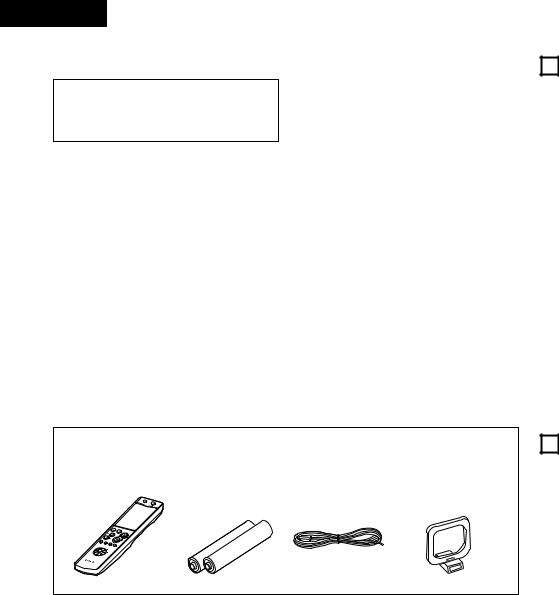
ENGLISH
IMPORTANT TO SAFETY
WARNING:
TO PREVENT FIRE OR SHOCK HAZARD,
DO NOT EXPOSE THIS APPLIANCE TO
RAIN OR MOISTURE.
Please, record and retain the Model name and serial number of your set shown on the rating label.
Model No. DRA-201SA |
Serial No. |
|
Thank you for purchasing this DENON stereo receiver. Please read the operation instructions thoroughly in order to acquaint yourself with the stereo receiver and achieve maximum satisfaction from it.
CAUTION
1.Handle the power supply cord carefully
Do not damage or deform the power supply cord. If it is damaged or deformed, it may cause electric shock or malfunction when used. When removing from wall outlet, be sure to remove by holding the plug attachment and not by pulling the cord.
2.Do not open the top cover
In order to prevent electric shock, do not open the top cover.
3.Do not place anything inside
Do not place metal objects or spill liquid inside the stereo receiver.
Electric shock or malfunction may result.
TABLE OF CONTENTS
z MAIN FEATURES ……………………………………… 4 x BEFORE USING ……………………………………… 4 c CONNECTING THE ANTENNAS …………………… 5 v CONNECTIONS …………………………………… 6, 7 b PART NAMES AND FUNCTIONS ………………… 8, 9 n SYSTEM REMOTE CONTROL ………………… 9~11
m OPERATION …………………………………… 12, 13
, LISTENING TO RADIO ………………………… 13~15
. USING THE TIMER ……………………………… 16~18
⁄0SYSTEM FUNCTIONS ……………………………… 18
⁄1TROUBLESHOOTING ……………………………… 19
⁄2SPECIFICATIONS …………………………………… 20
1MAIN FEATURES
1.HC-TR output circuit for both subtlety and power
A single push-pull circuit using an HC-TR (high current transistor) based on the same principles as the UHCMOS used in the POA-S1, DENON’s top grade monaural power amplifier, achieves both stable a high current supply and excellent low level signal linearity. The result is an extremely high level of both subtlety and power.
2.Strong power circuitry supporting the expressive abilities of the HC-TR output circuit
The strong power circuitry consisting of high speed rectifier diodes and large high sound quality block condensers allow the HC transistor output circuit to be used to its maximum potential.
3.S.L.D.C.
The DRA-201SA uses an S.L.D.C. (Signal Level Divided Construction) with the ideal separation of the different circuits (low level signal circuit, high level signal circuit, microprocessor circuit, etc.)
4.Source Direct function for improved sound quality
The DRA-201SA is equipped with a source direct function that bypasses the bass, treble, loudness and balance control circuits to achieve a simple signal path, contributing to keeping the sound pure.
5.RDS compatible
Compatible with various RDS service, including Program service name (PS), Program type identification (PTY), Traffic program identification (TP), Clock time (CT) and Radio text message (RT).
6.AM/FM tuner with random 40-station preset function
7.System remote control unit
The DRA-201SA comes with a system remote control unit that can be used to control the different components in the 201SA series (CD player, MD recorder and cassette deck, when used system connections only).
8.Low standby power consumption
The power consumption when the power is in the standby mode is reduced to 1W or less.
2ACCESSORIES
Check that the following parts are included in the package aside from the main unit:
q Remote control unit (RC-906) …………………………1 |
r AM loop antenna |
……………………………………1 |
w Batteries R03 (AAA) ……………………………………2 |
t Operating instructions …………………………………1 |
|
e FM indoor antenna ……………………………………1 |
y Service station list |
……………………………………1 |
q |
w |
e |
r |
|
++ |
|
|
|
-- |
|
|
2 BEFORE USING
Read the following before using the set.
•Before turning on the power
Check again that all connections are correct and that there are no problems with the connection cords. Be sure to unplug the power cord before connecting or disconnecting the connection cords.
•Moving the set
To prevent short-circuits or damage to the connection cords, always unplug the power cord and disconnect the connection cords between all other audio components when moving the set.
•Store this instructions in safe place
After reading, store this instructions along with the warranty in a safe place. Also fill in the items on the back paper for your convenience.
•Illustrations in this manual
Note that some of the illustrations used for explanations in this manual may differ from the actual set.
4
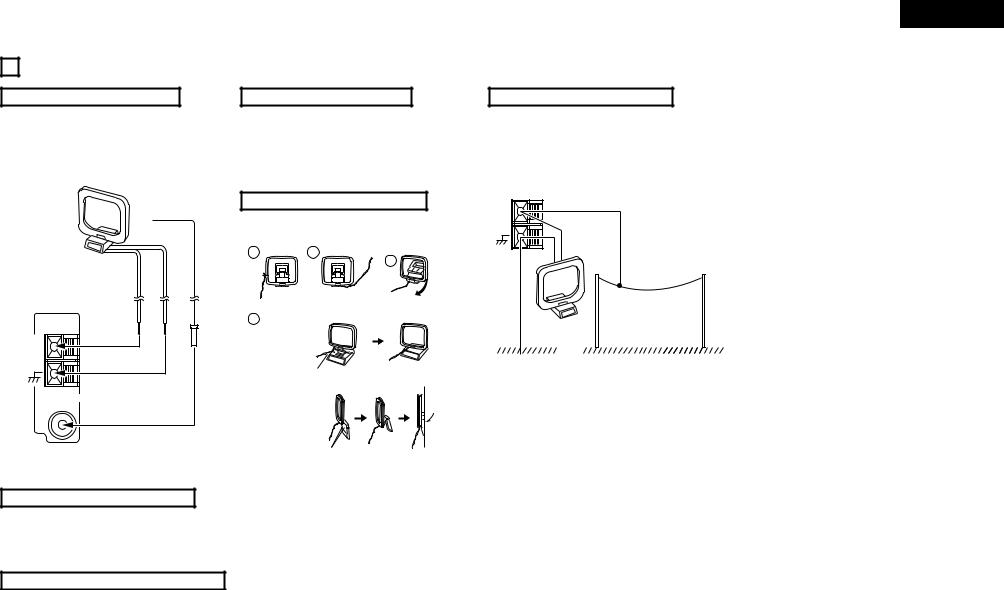
3 CONNECTING THE ANTENNAS
Installing the FM indoor antenna
Tune in FM station (see page 13), set the antenna so that distortion and noise is minimal, then secure the tip of the antenna in this position using tape or a pin.
AM loop antenna
Installing the AM loop antenna
Tune in an AM station (see page 13) and set the antenna as far from the system as possible to keep distortion and noise is minimal. In some cases, it is best to invert the polarities. AM broadcasts cannot be received well if the loop antenna is not connected or if it is set close to metal objects.
FM antenna
AM
LOOP
ANT.
ANTENNA
FM COAX. 75
Connecting an FM outdoor antenna
If good reception cannot be achieved with the included FM antenna, use an FM outdoor antenna. Connect an IECtype connector to the coaxial cable and connect the antenna to the FM COAX (75 Ω /ohms) terminal.
Selecting a place for the FM outdoor antenna
•Set the antenna so that it points towards the broadcast station’s transmitting antenna. Behind buildings or mountains, set the antenna in the position at which reception is best, and also try changing the direction of the antenna.
•Do not install the antenna under power lines.
Doing so is extremely dangerous, as the power line could touch the antenna.
•Install the antenna away from roads or train tracks to avoid noise from cars or trains.
•Do not install the antenna too high, as it may be hit by lightning.
Assembling the AM loop antenna
1 |
2 |
Remove the vinyl tie and take out the
connection line.
4
a.With the antenna on top any stable
surface.
Mount
b.With the antenna attached to a wall.
Connect to the AM antenna terminals.
3
Bend in the reverse direction.
Installation hole Mount on wall, etc.
ENGLISH
Installing an AM outdoor antenna
Connect the signal wire from the AM outdoor antenna to the antenna terminal. Be sure to connect the signal ground wire to the  terminal. Also be sure to connect the included AM loop antenna.
terminal. Also be sure to connect the included AM loop antenna.
AM
LOOP
ANT.
|
|
AM loop antenna |
AM outdoor antenna |
||
|
|
|
|
|
|
|
|
|
|
|
|
|
|
|
|
|
|
Signal ground
5
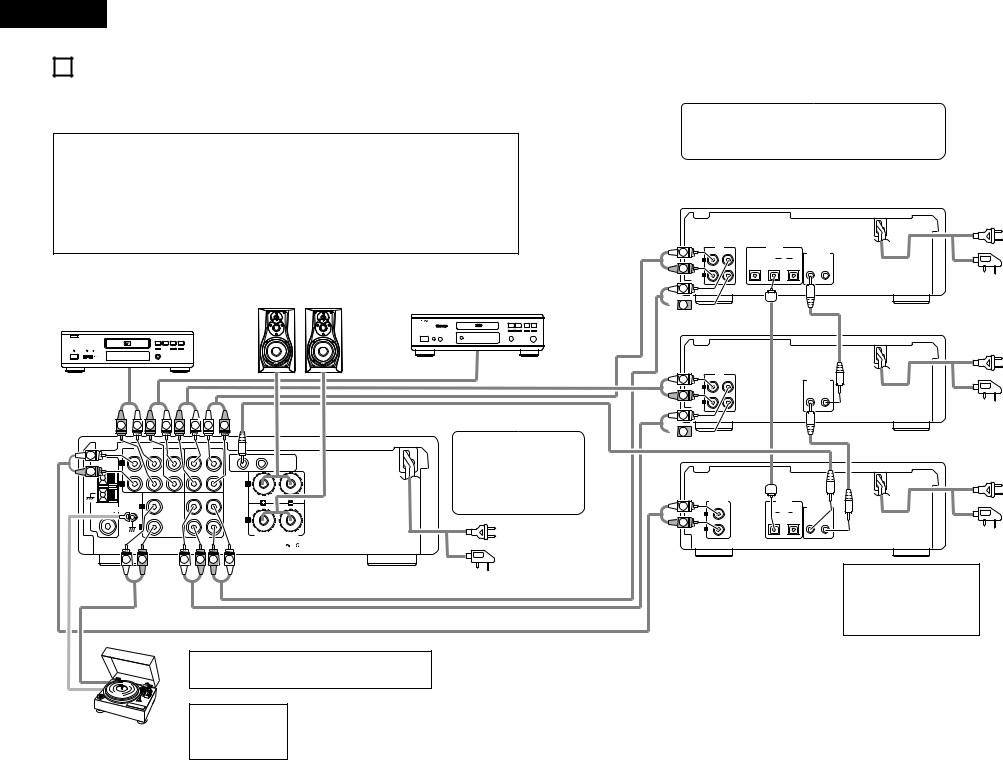
ENGLISH
4 CONNECTIONS
2When connecting, also refer to the manuals of the other components.
2When connecting to the 201SA series, make the system connections shown by dotted lines on the diagram below.
2The DRA-201SA is not equipped with connection cords. Use the connection cords included with the components you are connecting to the DRA-201SA.
NOTES:
•Do not plug the power cords into the power outlets until all connections have been completed.
•Check the left and right channels and be sure to interconnect them correctly (R to R, L to L).
•Plug in the power cords securely. Incomplete connections will result in noise.
•Do not clasp the connection cords together with the power cords or place them near other electric products. Doing so may result in noise.
•The PHONO input jack is extremely sensitive. A booming sound may be produced from the speakers if the volume is turned up when no turntable is connected.
•The sound of another component may be heard if no component is connected to the input jacks of the function selected with the FUNCTION selector.
Speaker system
CD player
DVD player
B
(L) |
(R) |
R |
L |
|
|
L |
R |
|
ANT. |
R |
ANTENNA
FM COAX. 75
L |
R |
L |
R |
L |
L |
R |
INPUTS |
TAPE |
PB |
|
|
CD DVD/AUX AUX-2 |
MD |
2 |
|
|
|
|
1 |
SYSTEM |
|
|
|
|
|
CONNECTOR |
|
|
|
L |
|
PHONO |
TAPE |
MD |
|
|
L |
|
|
|
|
•The 201SA series stereo receiver (DRA-201SA) is equipped with a clock and timer function, so be sure to connect it to a wall power outlet to which power is supplied constantly.
R |
Power plug |
|
R |
|
|
AC 230V, 50 Hz |
|
SIGNAL |
REC |
SPEAKER SYSTEM |
|||
(Plug into a power outlet) |
|||||
GND |
SPEAKER IMPEDANCE |
||||
|
|
4 |
16 |
|
|
L R |
L |
R R |
L |
Power cord |
|
(for U.K. model) |
|||||
|
|
|
|
Turntable (with MM cartridge)
NOTE:
•This unit cannot be used with MC cartridges directly. Use a head amplifier or a step-up transformer with MC cartridges.
NOTE:
•If noise is generated when the ground wire is connected, disconnect the ground wire.
•When making system connections with the 201SA series, connect the system cord to the DRA-201SA system connector (either 1 or 2). Also interconnect the other system components in the same way.
(System connections are indicated by dotted lines on the diagram.)
MD recorder (DMD-201SA)
Power plug
AC 230V, 50 Hz (Plug into a power outlet)
L |
|
LINE |
OUT |
IN |
|
|
L |
OUT |
|
|
|
R |
|
|
|
R |
|
L |
 R
R 
Cassette deck (DRR-201SA)
L |
|
LINE |
OUT |
IN |
L |
R |
R |
L |
 R
R 
DIGITAL |
|
|
|
|
OPTICAL |
|
|
|
SYSTEM |
1 |
IN |
2 |
CONNECTOR |
|
|
|
|||
|
|
|
1 |
2 |
SYSTEM
CONNECTOR
1 2
CD player (DCD-201SA)
L |
LINE OUT |
DIGITAL |
|
|
|
OPTICAL |
|
SYSTEM |
|
L |
1 |
OUT |
2 |
CONNECTOR |
R |
1 |
2 |
|
|
|
|
R |
|
Power cord
(for U.K. model)
Power plug
AC 230V, 50 Hz (Plug into a power outlet)
Power cord
(for U.K. model)
Power plug
AC 230V, 50 Hz (Plug into a power outlet)
Power cord
(for U.K. model)
NOTE:
•To allow for heat dispersal, do not place another component or any other object directly on top of the DRA-201SA.
6

System Operations
•System operations such as the timer recording/playback and auto power on functions can only be used if stereo audio cords and system cords are connected between all the system components. Be sure to securely connect all the connection cords between all the units.
•Disconnecting a system cord during system operation may result in malfunction. Be sure to unplug the power cords before changing the connections.
2Recommended System Installation
• To ensure performance and stability, install the system (201SA series) as shown below.
1 3 |
2 |
VOLUME |
5 |
|
|
(DMD-201SA) |
(DRA-201SA) |
+ |
MHz CH |
TUNED STEREO |
AUTO |
MINIDISC RECORDER DMD-201SA |
STEREO RECEIVERER DRA-201SA |
1 3 |
2 |
1 |
2 |
C |
|
|
|
55
(DCD-201SA) |
(DRR-201SA) |
L |
|
dB |
|
R |
+ |
3 |
DOLBY NR B |
COMPACT DISC PLAYER DCD-201SA |
STEREO CASSETTE TAPE DECK DRR-201SA |
Do not place another component directly on top of the DRA-201SA. To allow for heat dispersal, leave a space of at least 10 cm above the DRA-201SA so as not to obstruct its ventilation holes.
For stability, do not stack more than three components on top of each other.
For heat dispersal, leave at least 10 cm of space between the top, back and sides of this unit and the wall or other components.
|
10 cm or more |
|
|
|
|
|
|
5 cm |
|
|
|
|
|
|
|
|
VOLUME |
|
|
|
|
|
|
|
|
MHz |
CH |
|
|
TUNED STEREO |
AUTO |
|
|
|
|
|
STEREO RECEIVERER DRA-201SA |
|
|
• Switching the input function when input jacks are |
Please be sure to unplug the cord when you leave |
not connected |
home for, say, a vacation. |
A clicking noise may be produced if the input function is switched when nothing is connected to the input jacks. If this happens, either turn down the VOLUME control or connect components to the input jacks.
Connecting Speaker Systems
2 Speaker impedance
Use speaker systems with an impedance of 4 to 16Ω /ohms.
•Note that using speakers with other impedances will activate the protector circuit and may result in damage.
Protector Circuit
The DRA-201SA is equipped with a high speed protector circuit.
This circuit prevents strong currents from being generating inside the unit and damaging internal circuitry if the speaker cables are not securely connected to the speaker terminals or if they are short-circuited. If the protector circuit is activated, the speaker output is automatically cut off. If this happens, turn off the unit’s power, check the speaker cable connections, then turn the power back on. The sound will be muted for several seconds, after which the unit will operate normally.
ENGLISH
2 Connecting the speaker cords
q Peal off the coating from the tip of the cord. w Twist the core wire.
eTurn the speaker terminal counterclockwise to loosen it.
rCompletely insert the core wire, then turn the terminal clockwise to tighten it.
q w e r
BBe sure to connect the speaker cords to the terminals with the same polarities on the speaker and amplifier ( <to <, >to >).
BWhen connecting, make sure that the speaker cords’ core wires do not stick out and touch other terminals, other core wires or the rear panel.
NOTE:
•NEVER touch the speaker terminals while the set is connected to a power supply. Doing so may result in electric shock.
7
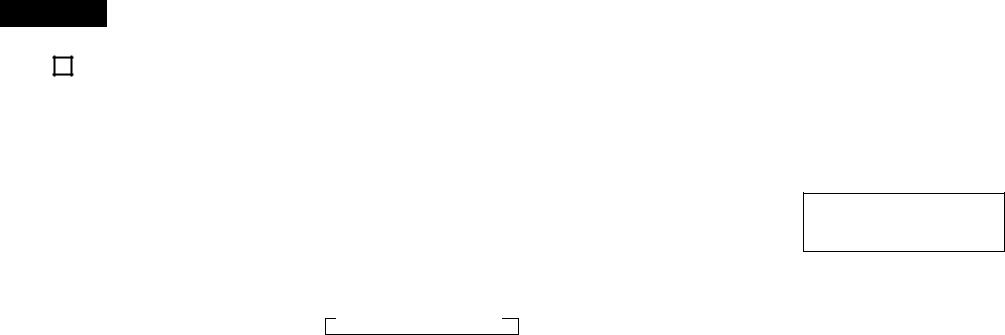
ENGLISH
5 PART NAMES AND FUNCTIONS
(1) Front Panel
qPower operation switch (ON/STANDBY)
•(This turns the power for the entire system on and off.)
•Press this once to turn the power on, then press again to set the power to STANDBY mode.
•The LED color changes as follows, according to the condition:
During power ON : green
During STANDBY : red
During TIMER STANDBY: orange
The muting mode is set when the main unit’s power button is pressed and when the standby mode is canceled from the remote control unit. The power indicator flashes green when in the muting mode, then stops flashing and turns green once the set is in the operational mode.
If the indicator is flashing orange (quickly): The protective circuit is activated.
If this happens, unplug the power cord to turn the indicator off, then check the input and output terminals on the rear panel. Check in particular for short-circuiting of the speaker cords. Once all connections have been corrected, plug the power cord. (Wait for at least 10 seconds after turning
the power off before turning it back on.)
•When the DRA-201SA is connected in a system with the 201SA series, its power button works as
the power button for the entire system. When the DRA-201SA’s power turns on, the power of all the connected system units also turns on.
Power is supplied to the DRA-201SA even when the power is in the standby mode (low power consumption).
wHeadphones jack (PHONES)
•Use this jack to listen to the sound over commercially available headphones.
•When the headphones’ plug is inserted into the jack, the speaker output is automatically cut off, so no sound is produced from the speakers.
eREMOTE SENSOR (Remote Control Sensor)
•Point the included remote control unit (RC-906) at this sensor when operating it.
rFunction dial (FUNCTION)
•Switches the input function. Also used to set the modes selected with the mode button.
(See pages 12, 13.)
tMode button (MODE)
•Use this to set the bass, treble and balance level. (Refer to pages 12, 13.)
•Use this to set the loudness function to on or off. (Refer to page 13.)
•Use this to set the speaker system. (Refer to page 13.)
yTimer button (TIMER)
•Press this button during power ON mode to confirm or change the display. Each time this button is pressed, the display changes as follows:
Frequency |
|
Clock |
|
Timer Standby |
|
|
Clock: Indicates the current time.
Timer Standby: Indicates the timer standby mode. Use the PRESET/TUNING buttons to set the timer standby mode on or off (refer to page 17).
•Press this buttons for at least 3 seconds to set the timer (refer to page 16) or to confirm the timer contents (refer to page 17).
Each time the PRESET/TUNING button is pressed, the display changes as follows:
|
|
TIME |
|
EVERYDAY |
|
ONCE |
|
|
|
|
|
|
|||
|
|
|
|
|
|
|
|
TIME: |
Use this to set the time. |
|
|
||||
EVERYDAY: Use this to set the everyday timer. ONCE: Use this to set the once timer.
•Press this button during in STANDBY mode to switch ON/OFF (“Saving Energy Mode”) the clock display.
uBand/RDS button (BAND/RDS)
•Each time this button is pressed, the band and FM reception mode change as follows.
|
FM AUTO |
|
FM MONO |
|
AM |
|
|
|
|
|
|||
|
|
|
|
|
|
|
•When the FM band, press this button for at least 3 seconds to select RDS search modes.
Each time this button is pressed, the display changes as follows:
|
RDS |
|
PTY |
|
TP |
|
|
|
|
|
|||
|
|
|
|
|
|
|
iMemory/set button (MEMORY/SET)
•Use this as the memory button when presetting AM and FM stations.
•Use this as the set button when setting the time and timer and when inputting data.
•When the PTY search mode, press this button to select the type of program.
•Press this button for at least 3 seconds to change the function of the PRESET/TUNING buttons (Preset mode or Tuning mode).
o Display
Refer to page 9.
!0 Preset/Tuning buttons (PRESET/TUNING UP AND DOWN)
•Use these buttons to call out the preset stations. (PRESET UP DOWN) (See page 14.)
•Use these buttons to tune in AM and FM stations. (TUNING UP/DOWN) (See page 13.)
!1 Source direct button (SOURCE DIRECT)
•When pressed and set to the “ON” position, the signals bypass the tone control (bass, treble, balance and loudness) circuits and are input directly to the volume circuit, resulting in higher quality sound.
•When pressed again and set to the “OFF” position, the signals pass through the tone control circuits, so the tone (bass, treble, balance and loudness) can be adjusted as desired.
!2 Volume control dial (VOLUME)
•Use this to adjust the overall volume. (Rotary Encoder System).
•The volume increases when the control is turned clockwise (,), decreases when it is turned counterclockwise (.).
•The volume increases and decreases in 70 steps from the minimum (VOLUME 0) to the maximum (VOLUME MAX).
(2) Rear Panel
!3 FM antenna terminal (ANTENNA TERMINAL FM)
• Connect the FM antenna here.
!4 SIGNAL GND (ground) terminal
•Connect the turntable’s ground wire here.
NOTE:
•This terminal is designed to reduce noise when a turntable is connected.
This is not a safety ground.
!5 INPUT terminals (INPUTS)
These are input terminals for CD player, turntable, DVD or other playback components.
• AUX-2:
Use these to connect a video deck or other component.
!6 TAPE and MD REC terminals (REC)
•Recording terminals (REC)
•These are output jacks for recording.
•TAPE:
Use these to connect a cassette deck.
• MD:
Use these to connect an MD recorder
!7 Power cord
• Plug this cord into a wall power outlet.
!8 Speaker terminals (SPEAKER SYSTEM)
• Use these to connect the speakers.
!9 System connectors
(SYSTEM CONNECTOR 1 and 2)
•When connecting the 201SA series in a system, connect these connectors to system connectors on other system components.
(Use the system cords included with the other components.)
@0 TAPE and MD PLAY terminals (PB)
• Playback terminals (PB)
@1 AM antenna terminal (ANTENNA TERMINAL AM)
• Connect the AM antenna here.
8
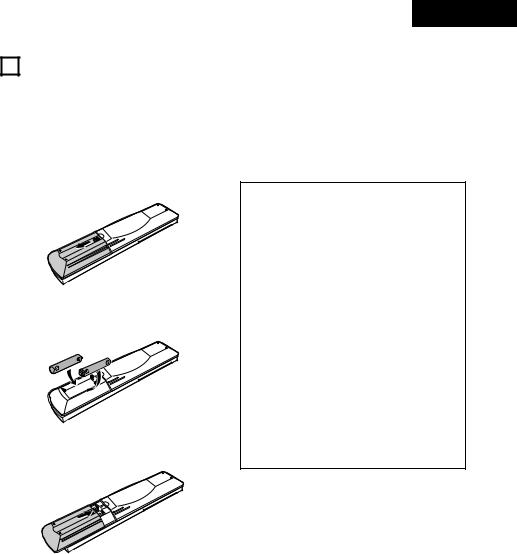
(3) Display [o]
@2 Mode indicators
•These indicate the various modes.
• :
:
This lights when the timer is set to the standby mode. It does not light if the current time and the timer have not been set.
• TIME:
This lights when the display is set to the time display.
• TIMER:
This lights when the timer is set.
It also lights while the timer is being set.
• ON:
This lights when the timer on time is set.
• OFF:
This lights when the timer off time is set.
• TUNED:
This lights when a station is properly tuned in.
• STEREO:
This lights in the AUTO mode when a stereo broadcast is tuned in.
• MONO:
This lights in the AUTO mode when a monaural broadcast is tuned in and when the MONO mode is set with the BAND button.
• AUTO:
This lights when the AUTO mode is set with the BAND button.
• MEMO:
This flashes when storing AM and FM stations in the preset memory to indicate that the station can be stored in the memory.
• SLEEP:
This lights when the sleep timer is activated.
• RDS (Radio Data System):
When the RDS button is pressed, a station is searched for and automatically tuned in, the “RDS” indicator lights and the station’s name is displayed on the frequency display.
• PS (Program Service Name):
This lights when the station name is displayed.
• TP (Traffic Program):
“TP” lights when an RDS traffic information station is received.
• PTY (Program Type):
This indicator lights when the type of RDS program is specified.
• RT (Radio Text):
“RT” lights when a station offering radio text services is tuned in.
@3 Preset number display
• The preset number is displayed here.
@4 Main display section
•The function, input program source, etc., are displayed here.
•During normal operation the input program source is displayed.
•When the mode button is pressed, the display switches to show the various functions.
•The reception band, reception frequency, time, timer setting times, etc., are displayed here.
ENGLISH
6 SYSTEM REMOTE CONTROL
2The included remote control unit (RC-906) can be used to perform the main operations of the units in the 201SA series that are connected with system connections. Other components cannot be operated with this remote control unit.
Note that some functions may not operate with system remote control units. In this case, use the remote control unit included with the component.
(1) Inserting Batteries
q Remove the remote control unit’s cover.
wInsert two R03 (AAA) batteries into the battery compartment in the direction indicated by the marks.
e Set the cover back in its original position.
Cautions on Batteries
•Use R03 (AAA) batteries in this remote control unit.
•Replace the batteries with new ones after approximately 1 year, though this depends on the frequency with which the remote control unit is used.
•Replace the batteries with new ones if the unit does not operate when the remote control unit is operated from nearby, even if the batteries are less than a year old.
•Be sure to insert the batteries in the proper direction, following the “ < ” and “ > ” marks in the battery compartment.
•To avoid damage or leakage of battery fluid:
•Do not use a new battery with an old one.
•Do not use two different types of batteries.
•Do not short-circuit, take apart, heat or dispose of batteries in flames.
•Remove the batteries when you do not plan to use the remote control unit for an extended period of time.
•If the battery fluid should leak, carefully wipe off the fluid from the inside of the battery compartment, then insert new batteries.
9
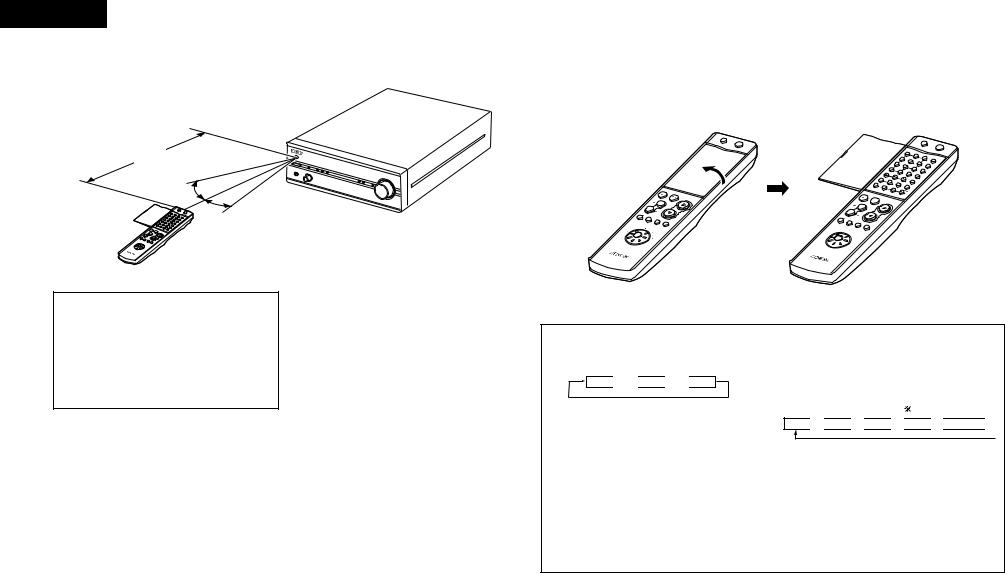
ENGLISH
(2) Using the Remote Control Unit
Approx. 7m
30°
30°
 + + --
+ + --
(3) Names and Functions of Remote Control Unit Buttons
2 Opening the remote control unit’s cover
+ |
PRESET |
|
|
+ |
|
|
- |
|
|
|
|
- |
|
|
|
|
TAPE |
|
|
|
|
SLEEP |
F |
UNCTI ON |
|
|
|
|
MODE |
|
|
|
|
|
|
TUNER |
CD |
|
|
|
TAPE |
|
|
|
|
|
MD |
|
|
|
|
CD-R |
|
||
REMOTE |
RC-906 |
|
CONTROL UNIT |
VOLUME /SELECT
OFF
SYSTEM |
ON |
|
|
|
STOP |
|
|
|
PRESET |
|
|
|
+ |
|
|
- |
+ |
|
|
|
|
|
|
- |
|
|
|
TAPE |
|
|
|
SLEEP |
FUNC ITON |
|
|
|
MODE |
|
|
|
|
|
TUNER |
CD |
|
|
TAPE |
|
|
|
|
|
MD |
|
|
CD-R |
|
|
REMOTE |
RC-906 |
|
CONTROL UNIT |
|
|
|
|
|
OFF |
|
|
|
|
|
|
SYS |
ON |
|
|
|
|
|
POWTEM |
|
|
|
|
|
|
ER |
|
|
|
|
1 |
|
|
|
|
|
|
2 |
|
|
|
|
|
4 |
55 |
3 |
D PIRERCOGT |
/ |
|
|
7 |
6 |
|
|
|
|
|
|
CALL |
|
||
|
|
|
8 |
|
|
|
+ |
|
9 |
CLEAR |
|
||
|
10 |
0 |
RANDOM |
|
||
CD- |
R |
CD |
REPEAT |
|
|
|
|
|
TAPSERS |
|
|
|
|
DOLBY |
|
|
MD |
|
|
|
|
MROEDE.V |
TIME EDIT |
|
|
||
RDS |
|
DIMMER |
TIME/ |
|
|
|
BAND |
|
|
PANEL |
|
|
|
|
|
TUNING |
|
|
|
|
|
|
PTY |
|
|
|
|
PLAY |
|
|
|
|
|
|
VOLU |
|
|
|
|
||
/SELECTME |
|
|
|
|
||
NOTES:
•The remote control unit may not work properly if the remote sensor is exposed to direct sunlight or strong artificial light or if there is an obstacle between the remote control unit and the remote sensor.
•Do not press the buttons on the main unit and the remote control unit at the same time. Doing so will result in malfunction.
•Point the remote control unit at the remote sensor on the main unit as shown on the diagram when operating it.
(When system connections are made, the remote control signals for all the system components are received at the DRA-201SA remote sensor.)
•The remote control unit can be used from a straight distance of about 7 meters, but this distance will be shorter if the there is an obstacle in the way or if the remote control unit is not pointed directly at the remote sensor.
•Use the remote control unit within a range of 30° to the left and right of the remote sensor.
RDS button
Use this button to automatically tune to stations using
the radio data system.
RDS 
 PTY
PTY 
 TP
TP
Press the PRESET < or > button after selecting “PTY” with the RDS button to select one of the 29 program type.
PANEL button
This button is used to select the panel mode.
Press this button when receiving RDS stations to select the frequency, PS, PTY, RT or CT display.
The display mode changes as follows each time the button pressed.
PS 
 PTY
PTY 
 RT
RT 

 CT
CT 
 Frequency
Frequency 


 CT display
CT display
Use this to correct the time of the clock on the DRA201SA. Press the PANEL button when the time service of an RDS station is being properly received.
“CT” and “TIME” are displayed and the DRA201SA’s clock is corrected. “NO CT” is displayed if the RDS station does not offer a time service and when the broadcast is not being received properly.
Note that this button will not function if the reception is poor.
10
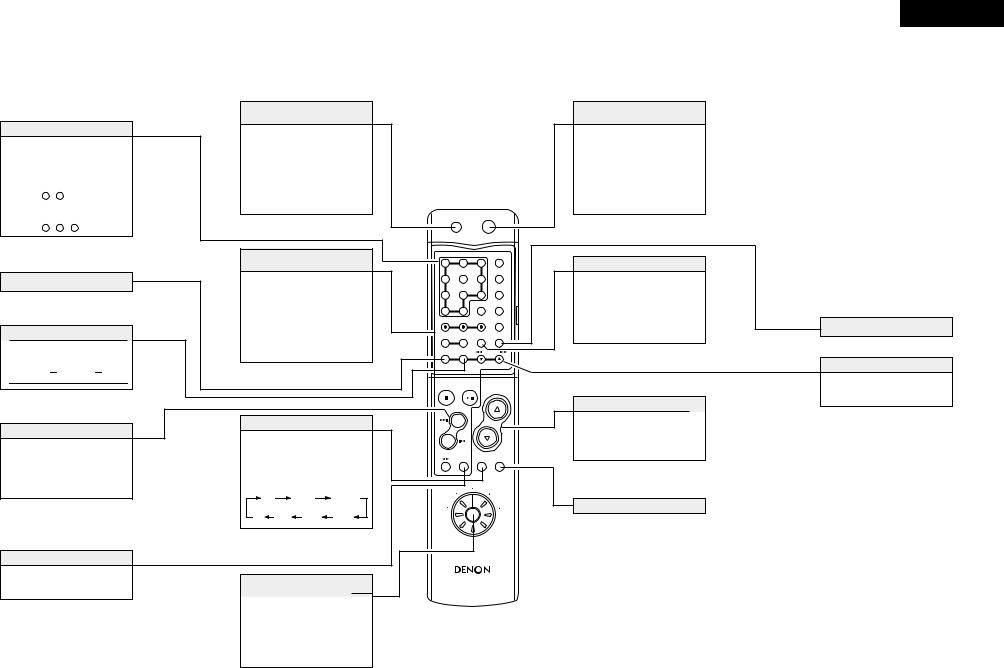
Number buttons
Press these buttons to recall preset station.
Examples:
To call the station at preset number 12:
Press +10 , 2
To call the station at preset number 29:
Press +10 , +10 , 9
RDS button (RDS)
BAND button (BAND)
Use this button to selecting the band.
 FM AUTO FM MONO AM
FM AUTO FM MONO AM 
PRESET button (PRESET)
Use these buttons to recall preset stations on the tuner.
Press this button after selecting “PTY” with RDS button to select one of the 29 program types.
SLEEP button (SLEEP)
Press this button to set the sleep timer
ENGLISH
2 Buttons not described here function in the same way as the corresponding buttons on the main unit.
Power standby button (SYSTEM POWER STANDBY)
Press this to set the DRA201SA’s power to the standby mode.
(When connected in a system with the 201SA series, this button sets the power of the entire system to the standby mode.)
201SA series function operation block
When connected in a system with the 201SA series, these buttons are used to operate the various connected system components.
For operating instructions, refer to the manuals of the various components.
FUNCTION button
Press this to select the function source to be played.
The function switches in the following order each time the button is pressed:
MD |
TAPE |
AUX-2 |
PHONO |
Remote control function selector switch
Use this to select the function to be operated with this remote control unit. For instructions on operating the various components, refer to their respective manuals.
Power on button (SYSTEM POWER ON)
OFF |
|
|
ON |
|
|
|
SYSTEM |
|
|
||
|
POWER |
|
|
||
|
|
|
|
|
PROG / |
|
|
|
|
|
DIRECT |
1 |
2 |
|
3 |
|
|
|
|
|
|
|
CALL |
4 |
5 |
|
6 |
|
|
|
|
|
|
|
CLEAR |
7 |
8 |
|
9 |
|
|
|
|
RANDOM |
REPEAT |
||
10 |
+10 |
|
|
|
|
|
CD SRS |
|
TIME EDIT |
||
CD-R |
TAPE |
|
MD |
||
Dolby NR |
REV. |
DIMMER |
TIME/ |
||
MODE |
PANEL |
||||
RDS |
BAND |
|
TUNING |
||
STOP |
PLAY |
|
VOLUME |
||
|
|
|
|
/SELECT |
|
PRESET |
|
|
|
|
|
|
+ |
|
|
|
|
- |
|
|
|
|
|
TAPE |
SLEEP FUNCTION |
MODE |
|||
|
|||||
|
|
CD |
|
|
|
TUNER |
|
|
|
|
MD |
TAPE |
CD-R |
RC-906
REMOTE CONTROL UNIT
When this button is pressed while the DRA-201SA’s power is in the standby mode, the DRA201SA’s power turns on.
(When connected in a system with the 201SA series, this button turns on the power of the entire system.)
DIMMER button
The display becomes darker (in 4 steps) each time this button is pressed.
Adjust the brightness of the display according to the brightness of the room.
VOLUME/SELECT buttons
•Press D to increase the volume, H to decrease it.
•These buttons are also used to set various modes.
MODE button
Models compatible with system remote control
• Receiver |
: |
DRA-201SA |
• CD player |
: |
DCD-201SA |
• Cassette deck |
: |
DRR-201SA |
• MD recorder |
: |
DMD-201SA |
PANEL button (PANEL)
TUNING button (•,ª)
Use these buttons to selecting the station.
The buttons above for which there are no explanations cannot be operated with the DRA-201SA.
11
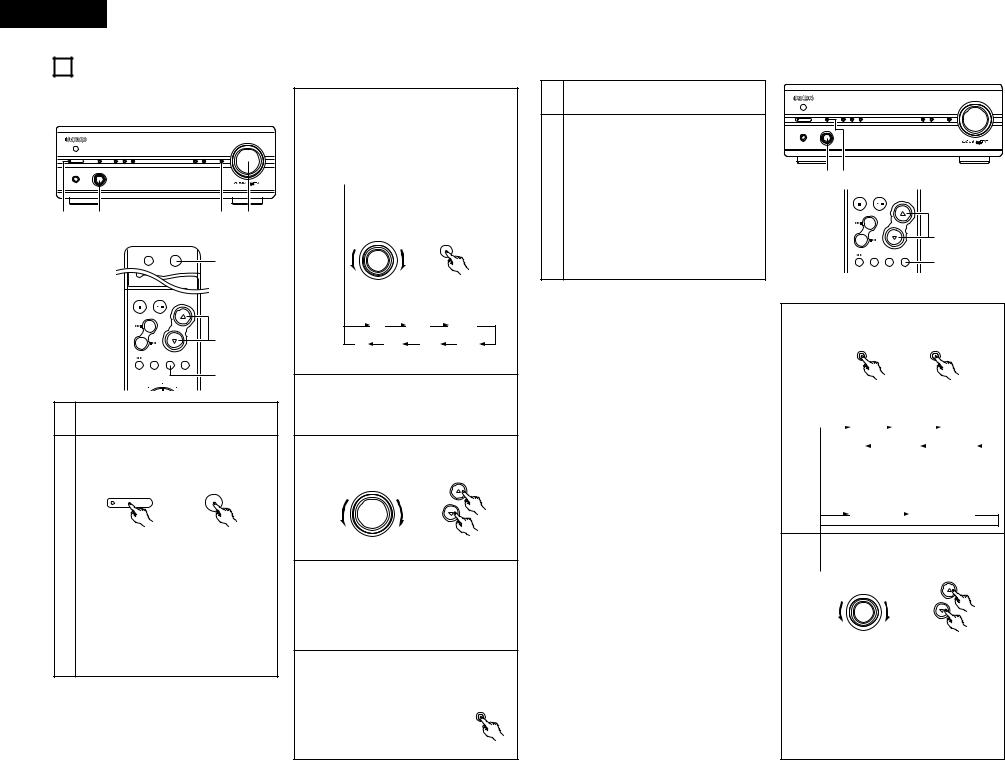
ENGLISH
7 OPERATION
(1) Playback
VOLUME
|
|
BAND |
MEMORY |
PRESET / TUNING |
SOURCE DIRECT |
|
ON / STANDBY |
MODE |
TIMER / RDS |
/ SET |
DOWN |
UP |
|
PHONES |
FUNCTION |
|
|
|
|
|
|
|
|
MHz |
|
|
CH |
TUNED STEREO AUTO
STEREO RECEIVERER DRA-201SA
2 |
3 |
|
|
7 |
5 |
|
|
OFF |
ON |
2 |
|
|
|
SYSTEM |
|
|
|
|
|
POWER |
|
|
|
|
|
|
|
|
|
|
|
|
PTY |
|
|
|
|
|
|
PROG / |
|
|
|
|
|
DIRECT |
|
|
1 |
2 |
3 |
|
|
|
STOP |
PLAY |
VOLUME |
|
|
|
|
|
/SELECT |
|
|
|
PRESET |
|
|
|
|
|
|
+ |
|
|
|
|
- |
|
|
5 |
|
|
TAPE |
SLEEP FUNCTION |
MODE |
|
|
|
|
|
|||
|
|
CD |
|
3 |
|
|
TUNER |
|
MD |
|
|
1 Check that all connections are correct.
Turn on the power.
•The indicator first flashes red, then turns green and stops flashing (remaining lit).
ON
ON / STANDBY
SYSTEM
POWER
|
(Main unit) |
(Remote control unit) |
2 |
2 Power on/standby mode and function |
|
memory |
|
|
BWhen the remote control unit is used to turn the DRA-201SA’s power on from the standby mode, the function is set to the function that was selected when the power was last set to the standby mode. (Last memory function)
BIf the function has been cleared from the memory, the function is set to “CD” when the DRA-201SA’s power is turned on.
Either turn the FUNCTION dial on the main unit or press the remote control unit’s FUNCTION button to select the function source to be played.
• The function switches in the order shown below.
The function switches in the opposite order when the dial is turned counterclockwise (.).
3 |
FUNCTION |
FUNCTION |
|
|
(Main unit) |
(Remote control unit) |
|
|
|
CD |
TUNER |
|
MD |
TAPE |
AUX-2 |
Start playback of the selected function source. 4 • For instructions on operation, refer to the
component’s operating instructions.
Adjust the volume.
|
|
VOLUME |
|
|
/SELECT |
5 |
VOLUME |
|
|
|
|
|
(Main unit) |
(Remote control unit) |
|
Adjust the BALANCE, BASS, and TREBLE |
|
6 |
controls and set the LOUDNESS position to the |
|
desired position. |
|
|
For instructions on adjusting, see “(3) Setting the various modes” on page 12, 13.
To use the source direct function:
Set the SOURCE DIRECT button to the “ON” position.
7 |
SOURCE DIRECT |
(Main unit)
(2) Recording
1 Follow step 1 to 4 under “(1) Playback”.
Start recording on the cassette deck or MD recorder.
For instructions, refer to the component’s operating instructions.
•Operating the VOLUME, BALANCE, BASS, TREBLE and the LOUDNESS controls will not
2 |
affect the sound being recorded. |
•When the function source is set to “MD”, recording is performed from the MD recorder onto the cassette deck. When the function source is set to “TAPE”, recording is performed from the cassette deck onto the MD recorder.
(3) Setting the various modes
VOLUME
|
|
BAND |
MEMORY |
|
PRESET / TUNING |
SOURCE DIRECT |
ON / STANDBY |
MODE |
TIMER / RDS |
/ SET |
|
DOWN UP |
|
PHONES |
FUNCTION |
|
|
|
|
|
|
|
|
|
MHz |
|
CH |
|
|
TUNED STEREO |
AUTO |
|
|
|
STEREO RECEIVERER DRA-201SA
2 |
1 |
|
|
STOP PLAY |
VOLUME |
|
|
/SELECT |
|
PRESET |
|
|
+ |
|
|
- |
2 |
TAPE
SLEEP FUNCTION MODE
1
[1] Adjusting the bass and treble
Press the MODE button to display the mode to be adjusted (“BASS” or “TREBLE”).
MODE MODE
(Main unit) (Remote control unit)
• The mode switches as follows each time the
1 |
button is pressed: |
|
|
|
|
|
|
|
|||||||
|
|
|
|
|
|
|
|
|
|
|
|
|
|
|
|
|
|
|
|
|
BASS |
|
|
TREBLE |
|
|
LOUDNESS |
|
|
||
|
|
|
|
|
|
|
|
|
|
|
|
|
|
||
|
|
|
|
Playback |
|
|
|
SPEAKER |
|
|
BALANCE |
|
|
||
|
|
|
|
|
|
|
|
|
|
|
|||||
|
|
|
|
|
|
|
|
|
|
|
|
|
|
||
|
|
|
function source |
|
|
|
|
|
|
|
|
||||
When the source direct mode is on, the mode switches as shown below (the BASS and TREBLE adjustment modes cannot be selected).
SPEAKER |
|
Playback function source |
|
||
|
|
|
Either turn the FUNCTION dial on the main unit or use the remote control unit’s SELECT buttons.
|
VOLUME |
|
/SELECT |
FUNCTION |
(increase) |
(decrease) |
(increase) |
|
(decrease) |
(Main unit) |
(Remote control unit) |
2
• To increase the bass or treble:
Turn the dial clockwise (,) or press the D button.
To decrease the bass or treble:
Turn the dial counterclockwise (.) or press the H button.
•The bass and treble can be adjusted within the range of –12 to 0 to +12 in steps of 2. The response is flat at 0.
12
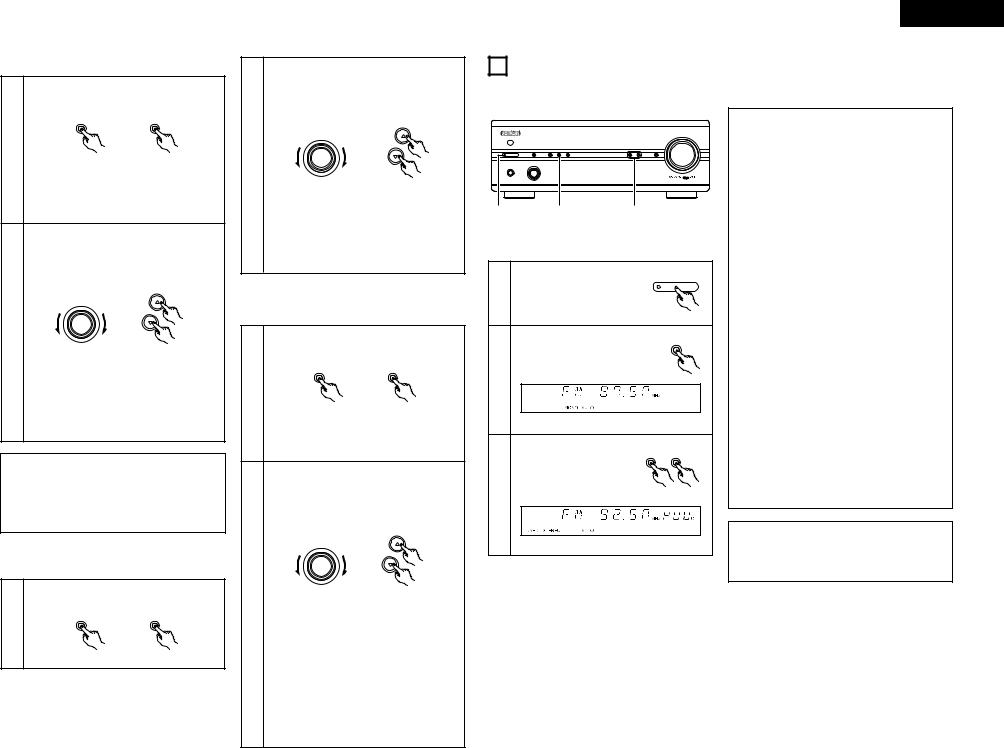
[2] Setting the loudness mode
Press the MODE button to display “LOUDNESS”.
MODE MODE
1 |
|
(Main unit) |
(Remote control unit) |
•The mode switches as shown at the left each time the button is pressed.
“LOUDNESS” cannot be selected when the source direct mode is on.
Either turn the FUNCTION dial on the main unit or use the remote control unit’s SELECT buttons.
VOLUME
/SELECT
FUNCTION |
(ON) |
(OFF) |
(ON) |
2 |
(OFF) |
|
|
(Main unit) |
(Remote control unit) |
• To set to “ON”: |
|
Turn the dial clockwise (,) or press the D |
|
button. |
|
To set to “OFF”: |
|
Turn the dial counterclockwise (.) or press |
|
the H button. |
|
NOTE:
The maximum total volume increase for the bass, treble and loudness together is +12. If for example the bass and treble are set to +12, the sound does not change when the loudness function is turned on and off.
[3] Setting the speaker mode
Press the MODE button to display “SPEAKER”. (Refer to page 12.)
MODE |
MODE |
1 |
|
(Main unit) |
(Remote control unit) |
Either turn the FUNCTION dial on the main unit or use the remote control unit’s SELECT buttons.
VOLUME
/SELECT
FUNCTION |
(ON) |
|
|
(OFF) |
(ON) |
2 |
(OFF) |
(Main unit) |
(Remote control unit) |
• To set to “ON”: |
|
Turn the dial clockwise (,) or press the D |
|
button. |
|
To set to “OFF”: |
|
Turn the dial counterclockwise (.) or press |
|
the H button. |
|
[4] Adjusting the balance
Press the MODE button to display “BALANCE” (Refer to page 12.)
MODE MODE
1 |
|
(Main unit) |
(Remote control unit) |
“BALANCE” cannot be selected when the source direct mode is on.
Either turn the FUNCTION dial on the main unit or use the remote control unit’s SELECT buttons.
|
(right |
VOLUME |
(left channel |
(left channel |
/SELECT |
volume |
|
channel |
|
||
volume FUNCTION |
volume |
|
adjustment) |
adjustment) |
adjustment) |
|
|
|
|
|
(right |
|
|
|
channel |
(Main unit) |
(Remote |
volume |
|
adjustment) |
|||
2 |
|
control unit) |
|
|
|
|
|
• If the volume of the right speaker is low: |
|||
Turn the dial clockwise (,) or press the D |
|||
button. |
|
|
|
If the volume of the left speaker is low: |
|||
Turn the dial counterclockwise (.) or press |
|||
the H button. |
|
|
|
•The balance can be set to “CENTER” or adjusted within the range of +1 to +10 in steps of 1. When set “CENTER”, the difference between the volume of the left and right speakers is 0.
8 LISTENING TO RADIO
(1) Tuning
VOLUME
|
|
BAND |
MEMORY |
|
PRESET / TUNING |
SOURCE DIRECT |
ON / STANDBY |
MODE |
TIMER / RDS |
/ SET |
|
DOWN UP |
|
PHONES |
FUNCTION |
|
|
|
|
|
|
|
|
|
MHz |
|
CH |
|
|
TUNED STEREO |
AUTO |
|
|
|
STEREO RECEIVERER DRA-201SA
1 2 3
Example: Tuning in FM 92.50 MHz
(AM stations are tuned in using the same procedure.)
ON / STANDBY
1 |
Press the power operation |
switch to turn on the power. |
BAND
/ RDS
Press the BAND/RDS button on the tuner to select the FM AUTO.
2
PRESET / TUNING
Use the PRESET/TUNING |
DOWN UP |
|
|
UP/DOWN button to tune |
|
the frequency to 92.50. |
|
3 This lights when a station is tuned in.
ENGLISH
The function of the UP/DOWN button on the main unit may toggle between TUNING UP/DOWN and PRESET UP/DOWN functions.
•Press the MEMORY/SET button for at least 3 seconds. Then press the UP button.
The function of the UP/DOWN buttons are changed to TUNING UP/DOWN.
•Press the MEMORY/SET button for at least 3 seconds. Then press the DOWN button. The function of the UP/DOWN buttons are changed to PRESET UP/DOWN.
•The UP/DOWN button is factory preset to function as a TUNING UP/DOWN button.
However, be sure that the UP/DOWN buttons function as the TUNING UP/DOWN button before proceeding with step 3.
Auto Tuning
•When a program being broadcast in stereo is received, the “STEREO” indicator lights and the program is received in stereo.
•If reception is poor and there is much noise in the stereo signals, press the BAND button to set the FM MONO mode.
•When one of the TUNING UP/DOWN button is pressed, the frequency changes in steps of 50 kHz in the FM band, 9 kHz in the AM band.
•If one of the TUNING UP/DOWN button is held for over 1 second, the frequency continues to change when the button is released (auto tuning) and stops when a station is tuned in. Tuning will not stop at stations whose reception is poor.
•To stop the auto tuning function, press the TUNING UP/DOWN button once.
NOTE:
A humming sound may be heard when using a TV nearby while receiving AM programs. If this happens, move the system as far from the TV as possible.
13
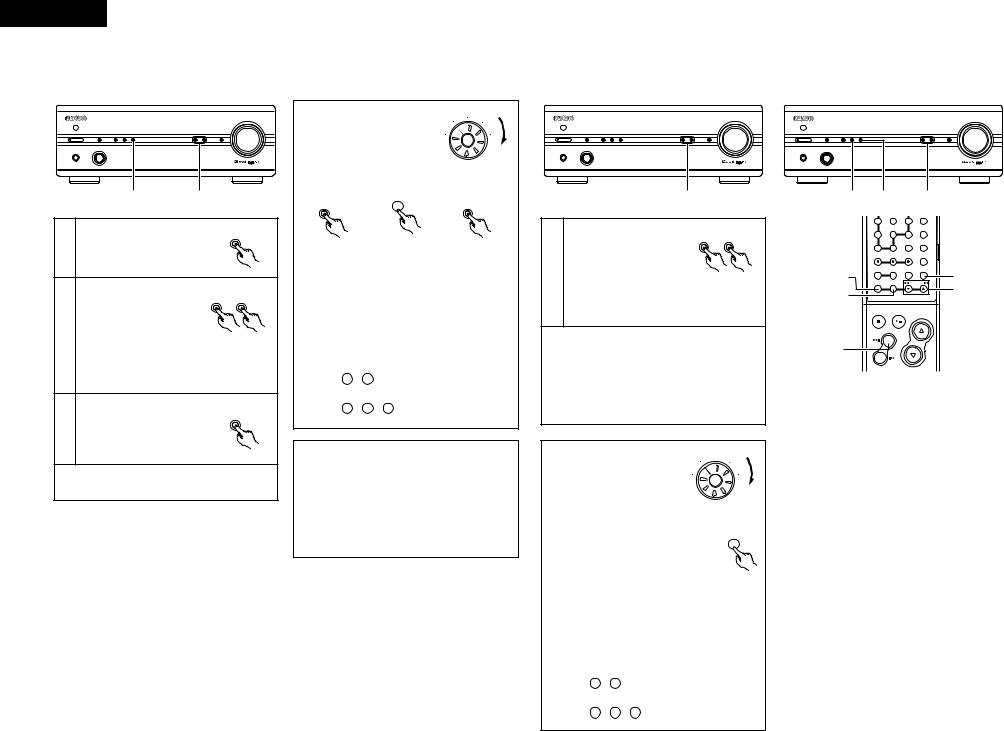
ENGLISH
(2) Presetting AM and FM stations
Example: To preset the currently tuned in FM station at preset number “3”
VOLUME
|
|
BAND |
MEMORY |
|
PRESET / TUNING |
|
SOURCE DIRECT |
ON / STANDBY |
MODE |
TIMER / RDS |
/ SET |
|
DOWN UP |
|
|
PHONES |
FUNCTION |
|
|
|
|
|
|
|
|
|
|
|
MHz |
CH |
|
|
|
TUNED STEREO |
AUTO |
|
|
|
|
|
|
|
|
|
|
|
STEREO RECEIVERER DRA-201SA |
|
|
1, 3 |
|
2 |
|
|
|
|
Press the MEMORY/SET button. |
MEMORY |
|||||
|
/ SET |
||||||
1 |
|
||||||
• The |
“MEMO” |
indicator |
|
||||
|
flashes. |
|
|
|
|
|
|
|
While the “MEMO” indicator |
PRESET / TUNING |
|||||
|
is flashing, |
press |
the |
DOWN UP |
|||
|
|
|
|||||
|
PRESET/TUNING UP button |
|
|
||||
|
three times to display “P3”. |
|
|
||||
2
To store the station at a different preset number, use the tuning buttons (PRESET/TUNING UP or DOWN) to set the desired preset number.
Press the MEMORY/SET button |
MEMORY |
again while the “MEMO” |
/ SET |
|
|
3 indicator is flashing. |
|
•The “MEMO” indicator turns off and the station is preset.
A total of 40 AM and FM stations can be preset using this procedure.
When operating with the |
TUNER |
CD |
|
system remote control unit, |
MD |
||
|
|
||
first set the remote control |
TAPE |
CD- |
|
|
|
||
unit’s function selector switch |
|
|
|
to “TUNER”. |
|
|
|
|
|
|
(RC-906) |
Procedure |
|
|
|
MEMORY |
|
|
MEMORY |
/ SET |
3 |
|
/ SET |
|
|
|
|
/ |
|
/ |
|
DRA-201SA |
(RC-906) |
|
DRA-201SA |
(this unit) |
|
|
(this unit) |
•This setting can also be made by pressing the
 TUNING
TUNING 
 button three times instead of pressing
button three times instead of pressing
“e”.
•To store the station at a different preset number, use the number buttons and the +10 button on the
system remote control unit (RC-906) to set the desired preset number.
Examples:
To store the station at preset number 12:
Press +10 , 2
To store the station at preset number 29:
Press +10 , +10 , 9
Presetting
•When a station is preset, both the reception frequency and reception mode are stored in the memory.
•If a station is preset at a number where another station is already preset, the previous station is erased and the new station is set.
•The preset memory is not erased immediately if the power supply is cut off momentarily.
(3) Tuning in Preset Stations |
(4) Using the RDS functions |
Example: To tune in the station stored at preset number “3”
VOLUME |
VOLUME |
|
|
BAND |
MEMORY |
PRESET / TUNING |
SOURCE DIRECT |
|
|
BAND |
MEMORY |
PRESET / TUNING |
|
||
ON / STANDBY |
MODE |
TIMER / RDS |
/ SET |
DOWN |
UP |
ON / STANDBY |
MODE |
TIMER / RDS |
/ SET |
DOWN |
UP |
SOURCE DIRECT |
|
PHONES |
FUNCTION |
|
|
|
|
|
PHONES |
FUNCTION |
|
|
|
|
|
|
|
|
MHz |
|
|
CH |
|
|
|
MHz |
|
|
CH |
TUNED STEREO AUTO |
|
|
TUNED |
STEREO |
AUTO |
|
|
|
|
|
|
STEREO RECEIVERER DRA-201SA |
|
|
|
|
|
|
STEREO RECEIVERER DRA-201SA |
|
1 |
|
1, 2, 5, 9 |
6 |
3, 7,10 |
|
|||
|
|
|
RC-906 |
|
|
|
|
CALL |
|
|
|
|
|
4 |
5 |
6 |
|
|
|
|
PRESET / TUNING |
(system remote |
|
|
|
|
CLEAR |
|
|
Press the PRESET UP |
control unit) |
|
7 |
8 |
9 |
|
|
||
DOWN |
UP |
|
|
|
|||||
|
|
|
|
|
|
RANDOM REPEAT |
|
||
button three times to display |
|
|
|
|
10 |
+10 |
|
|
|
|
|
|
|
|
CD SRS |
|
TIME EDIT |
|
|
“P3”. |
|
|
|
|
CD-R |
TAPE |
MD |
|
|
|
|
|
|
|
|
|
|
|
|
1 |
|
|
|
|
Dolby NR |
REV. |
|
TIME/ |
|
|
|
2,5,9 |
|
MODE |
DIMMER PANEL |
12 |
|||
|
|
|
|
||||||
|
|
|
|
RDS |
BAND |
TUNING |
|||
Be sure that the UP/DOWN buttons function |
1 |
|
|
|
|
|
3,7,10 |
||
as the PRESET UP/DOWN buttons before |
|
|
|
|
|
|
|||
proceeding with step 1. |
|
|
|
|
STOP |
PLAY |
/SELECT |
|
|
|
|
|
|
|
VOLUME |
|
|||
|
|
|
|
|
PRESET |
|
|
|
|
Preset stations can also be called out using the |
6 |
|
|
+ |
|
|
|
||
preset buttons (PRESET UP and DOWN) after a |
|
- |
|
|
|
|
|||
preset number is called out. |
|
|
|
|
|
|
|
|
|
|
|
|
|
TAPE |
|
|
|
|
|
Example: |
|
|
|
|
|
|
|
|
|
|
|
|
|
|
|
|
|
|
|
After calling out “P3”, press the PRESET UP button to call out “P4”, the PRESET DOWN button to call out “P2”.
When operating with the system remote control unit, first set the remote control unit’s function selector switch to “TUNER”.
Procedure:
CD TUNER  MD
MD
TAPE |
CD- |
(RC-906)
• Instead of pressing e, the preset
3 channel can also be called out by 
pressing the < or > button to display
“P3”.
•To call the station at a different preset number, use the number buttons and the +10 button on the
system remote control unit (RC-906) to set the
desired preset number.
Examples:
To call the station at preset number 12:
Press +10 , 2
To call the station at preset number 29:
Press +10 , +10 , 9
14
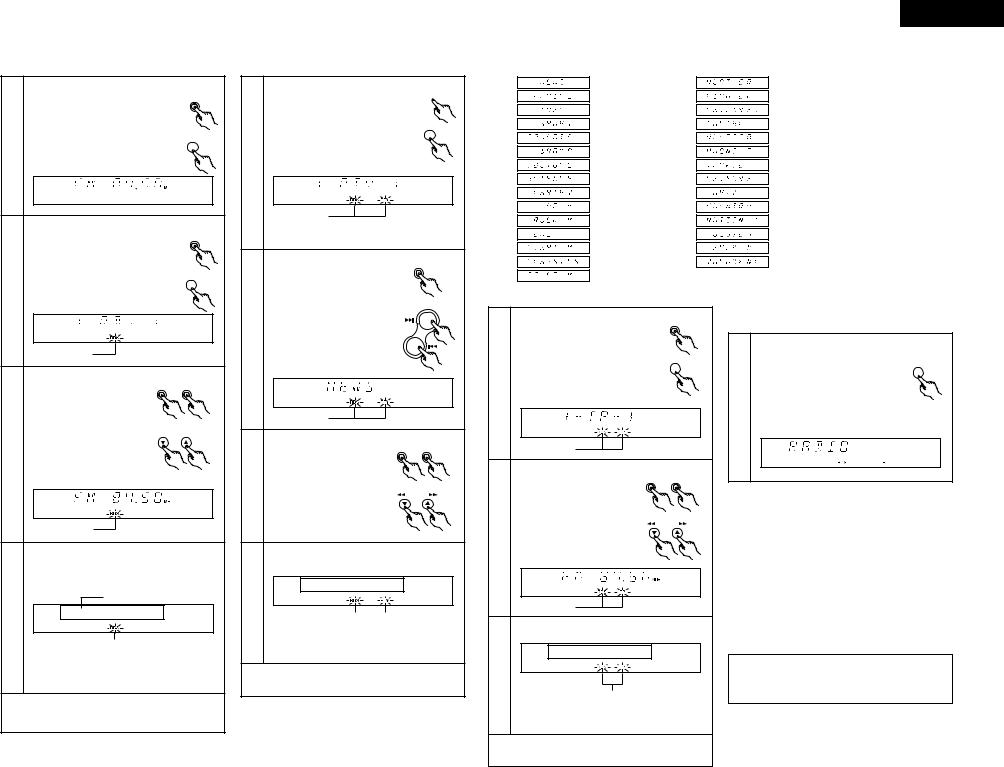
Receiving RDS broadcasts (FM only)
BAND
Press the BAND/RDS button and set / RDS the FM AUTO.
1 |
Press the BAND button on the |
BAND |
remote control unit and set the FM |
|
|
|
AUTO. |
|
BAND
Press the BAND/RDS button for at / RDS least 3 seconds.
|
Press the RDS button on the remote |
RDS |
2 |
control unit. |
|
Flashes
PRESET / TUNING
DOWN UP
Press the PRESET/TUNING
UP or DOWN button.
 TUNING
TUNING 
Press the TUNING • or ª 3 button on the remote control
unit.
Flashes
The station is tuned in.
Station name
4
”RDS“ lights after 5 seconds of flashing.
Once the station is tuned in, ”RDS“ flashes for 5 seconds and program service name is displayed.
NOTE: • If no RDS station is found, ” NO PROG “ is displayed.
PTY Search
BAND
Press the BAND/RDS button for at / RDS least 3 seconds. Then press the  BAND/RDS button once.
BAND/RDS button once.
RDS
Press the RDS button twice on the remote control unit.
5
Flashes
(”PTY“ and ”RDS“ flash, and ”, PTY /“ is displayed.)
|
MEMORY |
|
Press the MEMORY/SET button |
/ SET |
|
|
||
to select the type of program. |
|
|
Press the PRESET < or > |
|
|
button on the remote control |
PRESET |
|
unit to select the type of |
+ |
|
program. |
||
|
||
6 (One of the 29 types listed |
- |
|
below can be selected.) |
Flashes
PRESET / TUNING
DOWN UP
Press the PRESET/TUNING
UP or DOWN button.
7
Press the TUNING • or ª |
TUNING |
|
|
button on the remote control |
|
unit. |
|
The station is tuned in.
 Station name
Station name
8
”PTY“ and ”RDS“ light after 5 seconds of flashing.
Once the station is tuned in, ”RDS“ and ”PTY“ flash for 5 seconds and the program service name is displayed.
NOTE: If no program of the specified type is found,” NO PROG “ is displayed.
Programs
(News)
(Affairs)
(Information)
(Sport)
(Education)
(Drama)
(Culture)
(Science)
(Varied)
(Pop Music)
(Rock Music)
(Easy Listening)
(Light Classics)
(Serious Classics)
(Other Music)
TP Search
Press the BAND/RDS button for at |
BAND |
/ RDS |
|
least 3 seconds. |
|
The press the BAND/RDS button |
|
twice. |
|
|
RDS |
Press the RDS button 3 times on 9 the remote control unit.
Flashes
PRESET / TUNING
DOWN UP
Press the PRESET/TUNING
UP or DOWN button.
Press the TUNING • or ª |
TUNING |
|
|
10 button on the remote |
|
control unit. |
|
Flashes
The station is tuned in.
11
“TP” and “RDS” light after 5 seconds of flashing.
Once the station is tuned in, ”TP“ and ”RDS“ light and program service name is displayed.
NOTE: ” NO PROG “ is displayed when there is traffic information broadcast station.
ENGLISH
(Weather & Meteorological) (Finance)
(Children's Progs) (Social Affairs) (Religion)
(Phone In)
(Travel & Touring)
(Leisure & Hobby) (Jazz Music) (Country Music) (National Music) (Oldies Music) (Folk Music) (Documentary)
RT (Radio Text)
(This operation is only possible from the remote control unit RC-906)
|
To turn the RT mode on, press the |
|
PANEL button on the remote control TIME/ |
|
PANEL |
|
unit until the RT indicator is lit. (Refer |
|
to page 11.) |
|
When the station currently tuned in is |
12 |
offering a radio text message service, |
|
the message scrolls on the display. |
•When the RT mode is turned on while an RDS radio station not offering an RT service is tuned in, ” NO TEXT “ flashes on the display, then the mode automatically switches to the PS mode.
•In the same way, the mode automatically switches to the PS mode when the RT service is finished. In this case, the mode automatically switches from the PS mode back to the RT mode when an RT broadcast is resumed.
•The RT mode cannot be set in the AM band or FM stations not offering RDS broadcasts.
•To turn the RT mode off, press the PANEL button and switch to the desired display mode.
NOTE:
The PANEL function can only be operated with the remote control unit (RC-906).
15
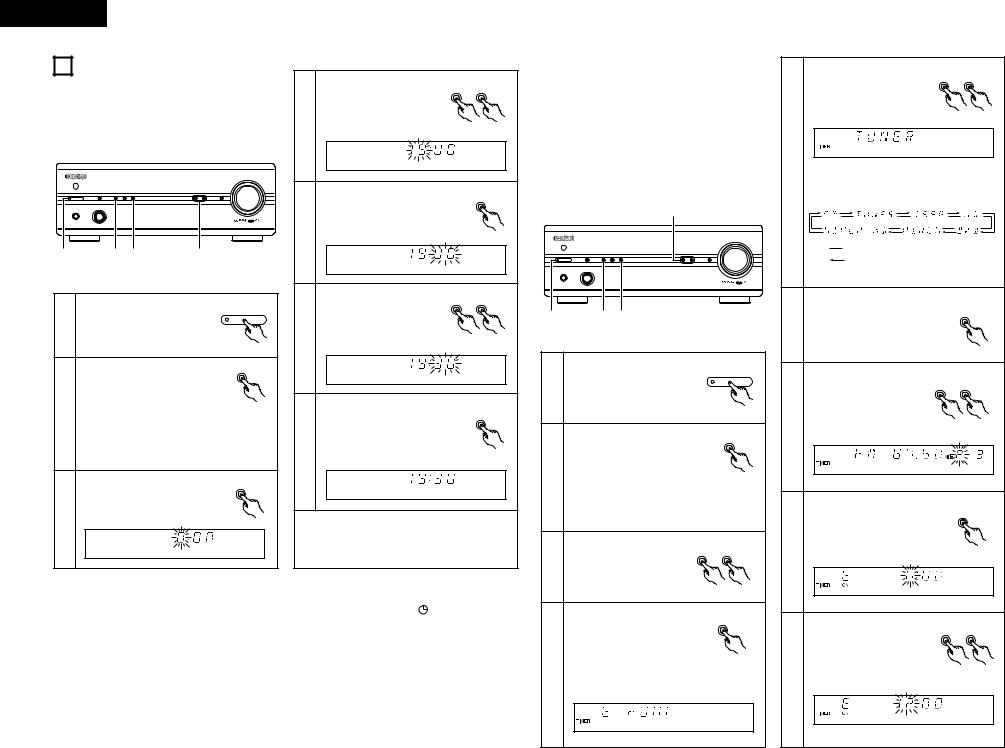
ENGLISH
9 USING THE TIMER
(1) Setting the Current Time (24-hour display)
Example: Setting the current time to 19:30
VOLUME
|
|
BAND |
MEMORY |
|
PRESET / TUNING |
SOURCE DIRECT |
ON / STANDBY |
MODE |
TIMER / RDS |
/ SET |
|
DOWN UP |
|
PHONES |
FUNCTION |
|
|
|
|
|
|
|
|
|
|
MHz |
CH |
|
|
TUNED STEREO |
AUTO |
|
|
|
|
|
|
|
|
|
STEREO RECEIVERER DRA-201SA |
1 |
|
2 |
3, 5, 7 |
4, 6 |
||
|
|
|
|
|
|
ON / STANDBY |
1 |
Turn on the power. |
|
|
|||
|
|
|
|
|
|
TIMER |
|
Press the TIMER button for at least |
|||||
|
3 seconds. |
|
|
|
|
|
|
• “TIME” is displayed. |
|
||||
2 |
If |
the |
time |
is |
already |
set, |
“EVERYDAY” is displayed. |
|
|||||
|
Press one of the PRESET/TUNING |
|||||
|
buttons to display “TIME”, then |
|||||
|
perform step 3. |
|
|
|
||
|
|
|
|
|
|
MEMORY |
|
|
|
|
|
|
/ SET |
|
Press the MEMORY/SET button. |
|||||
• The hours position flashes.
3
|
Use the PRESET/TUNING |
PRESET / TUNING |
|
buttons to input the hours |
DOWN UP |
|
|
|
|
(19). |
|
4 |
• “19” flashes in the hours |
|
position. |
|
|
Press the MEMORY/SET button. |
MEMORY |
|
/ SET |
|
|
• “19” stops flashing, remaining |
|
|
lit, and the minutes position |
|
5 |
starts flashing. |
|
|
|
|
Use the PRESET/TUNING |
PRESET / TUNING |
||
|
buttons |
to input |
the |
DOWN UP |
|
|
|||
|
minutes (30). |
|
|
|
6 |
• “30” |
flashes in |
the |
|
minutes position. |
|
|
||
|
Press the MEMORY/SET button |
MEMORY |
|
at the sound of the chime of a |
|
|
/ SET |
|
|
time service, etc. |
|
|
• “30” stops flashing, remaining |
|
7 |
lit, and the current time is |
|
displayed. |
|
|
|
|
The number changes continuously when one of the tuning buttons (TUNING UP or DOWN) is pressed.
If the time is already set when step 2, 3 is performed, both the hours and minutes positions flash.
(2) Before Setting the Timer
2 Be sure to set the current time. If the current time is not set, the timer standby indicator (“ ”) will not light and the timer will not function.
2Be sure to preset the station before setting the timer. (Refer to “Presetting AM and FM stations” on page 14.)
2The DRA-201SA is equipped with two types of timers: the everyday time which turns the power on and off at the same times every day, and the once timer that turns the power on and off only once.
2Do not change the timer standby mode after the timer is activated (after the timer on time is reached). The timer may not operate properly.
2It is not possible to set the timer start and end times to the same time.
2If the display or operation is not normal, unplug the power cord, then plug it back in while pressing the memory/set button (MEMORY/SET). This restores the tuner to the initial default values. After doing this, reset the presettings, current time and timer settings.
2When setting the timer to operate the CD player, MD recorder or cassette deck, do so with a disc or cassette loaded and the disc holder or cassette holder closed. The timer will not operate properly if no disc or cassette is loaded or if the disc holder or cassette holder is open.
(3) Setting the Timer
2The timer function lets you switch the power between the on and standby modes automatically at the desired times.
2When connected in a system with the 201SA series, the timer can be used to play a CD, cassette or MD or to record from the tuner onto the MD recorder or cassette deck (“air check”).
Example: Using the everyday timer to listen to the station stored at preset number 3 (FM 98.00 MHz) from 12:35 to 12:56
3, 5, 7, 9,11,13,15,17
|
|
|
VOLUME |
|
BAND |
MEMORY |
PRESET / TUNING |
ON / STANDBY |
MODE TIMER / RDS |
/ SET |
DOWN UP SOURCE DIRECT |
PHONES |
FUNCTION |
|
|
|
|
MHz |
CH |
|
TUNED STEREO AUTO |
|
|
|
|
|
STEREO RECEIVERER DRA-201SA |
1,18 |
2 |
4, 6, 8,10,12,14,16 |
|
|
|
|
ON / STANDBY |
1 |
Turn on the power. |
|
|
TIMER
Press the TIMER button for at least 3 seconds.
• “EVERYDAY” is displayed.
2
If the time is not set, “TIME” is displayed. Perform steps 3 to 7 on page 16, then start the timer setting over.
|
Press one of the |
PRESET / TUNING |
|
|
DOWN UP |
||
3 |
PRESET/TUNING buttons |
|
|
to display “EVERYDAY” or |
|
|
|
|
“ONCE”. |
|
|
|
Press the MEMORY/SET button. |
MEMORY |
|
|
/ SET |
||
|
• This sets the unit to the timer |
|
|
|
setting mode’s function |
|
|
|
setting mode. |
|
|
4 Example: When the everyday timer is selected
PRESET / TUNING
DOWN UP
Use the PRESET/TUNING
buttons to switch the function to “TUNER”.
5 |
The function switches as follows each time |
||
|
|||
|
the button is pressed: |
|
|
|
: When the TUNING UP button is pressed. |
||
|
: When the TUNING DOWN button is |
||
|
pressed. |
|
|
|
Press the MEMORY/SET button. |
MEMORY |
|
|
/ SET |
||
6 • “TUNER” is stored in the |
|
||
|
memory as the timer function. |
|
|
|
Use the PRESET/TUNING |
PRESET / TUNING |
|
|
DOWN UP |
||
|
|
|
|
|
buttons to set preset |
|
|
|
number 3. |
|
|
7
|
Press the MEMORY/SET MEMORY |
|
|
button. |
/ SET |
|
|
|
|
• The preset station is stored in |
|
|
the memory and the timer on |
|
8 |
time setting mode is set. |
|
|
|
|
<Setting the |
PRESET / TUNING |
DOWN UP |
|
PRESET/TUNING on time> |
|
Use the tuning buttons to set the hours position to “12”.
9
16

MEMORY
Press the MEMORY/SET button. |
/ SET |
• “12” is stored in the memory |
|
for the hours position. |
|
10
PRESET / TUNING
Use the PRESET/TUNING DOWN UP buttons to set the minutes 
position to “35”.
11
|
Press the MEMORY/SET button. |
MEMORY |
|
• The on time is stored in the |
/ SET |
|
|
|
|
memory and the timer off time |
|
12 |
setting mode is set. |
|
|
|
<Setting the timer off |
PRESET / TUNING |
time> |
DOWN UP |
|
|
Use the PRESET/TUNING |
|
buttons to set the hours |
|
13 position to “12”. |
|
MEMORY
Press the MEMORY/SET button. |
/ SET |
• “12” is stored in the memory |
|
for the hours position. |
|
14
PRESET / TUNING
Use the PRESET/TUNING DOWN UP buttons to set the minutes 
position to “56”.
15
|
Press the MEMORY/SET button. |
|
MEMORY |
|
|
/ SET |
|
16 |
• The off time is stored in the |
|
|
|
memory. |
|
|
|
Use the PRESET/TUNING |
|
PRESET / TUNING |
|
DOWN UP |
||
|
Button to select ”E oN”. |
|
|
17 |
• The “ ” mark lights. |
|
|
|
|
|
|
|
Turn off the power. |
|
|
|
When the DRA-201SA is |
|
ON / STANDBY |
|
connected in a system with |
|
|
|
|
|
|
18 |
the 201SA series, press the |
|
|
power button on the receiver. |
|
|
|
•The standby mode is set. (The power switch indicator turn orange and display turn off.)
Turning on and off the timer standby ON/OFF
•In TIMER STANDBY mode, each time the PRESET/TUNING button is pressed, the setting changes as follows:
1 1 oN/E oN: Both once and everyday timers
1
1
1_ _/E oN:
1 1
1 oN/E_ _:
1 1
1 1_ _/E_ _:
are activated. (The  mark lights.)
mark lights.)
Only the everyday timer is activated. (The  mark lights.) Only the once timer is activated. (The
mark lights.) Only the once timer is activated. (The  mark lights.)
mark lights.)
Both timers are canceled. (The  mark turns off.)
mark turns off.)
•When you set only the everyday timer, the indication changes between 1_ _/E_ _ and 1_ _/E oN.
•When you set only the once timer, the indication changes between 1_ _/E_ _ and 1 oN/E_ _.
•When you complete the setting, the display automatically returns to the former state after 5 seconds.
•To change the settings of TIMER STANDBY, press TIMER button to set the unit in TIMER STANDBY mode first, the use PRESET/TUNING button to make changes.
When the timer start time is reached, the timer operates.
If “ONCE” is selected in step 3, the once timer setting mode is selected. Set the timer using the same procedure. At steps 4 and 8 through 15, “1” (for once) is displayed instead of “E”.
The once timer is activated when “1 oN” is displayed at step 17.
ENGLISH
NOTES:
•The timer standby indicator (“  ”) will not light if the current time is not set. If this happens, set the
”) will not light if the current time is not set. If this happens, set the
current time. (Refer to “Setting the Current Time” on page 16.)
•When the timer on time is reached while in the standby mode, operation switches to the operation set with the timer. (The timer setting has priority.)
•Set the standby mode when using the timer. The timer may not operate properly if the power is on.
(4) Using the timer
The time and timer functions are incorporated in this unit.
Timer Settings
2 Types of timer operations
EVERYDAY TIMER : Use this to turn the power on and standby at the same times every day.
ONCE TIMER |
: Use this to turn the power on and standby once. |
SLEEP TIMER |
: Use this to set the power to turn standby after 10 to 60 minutes, in steps of 10 minutes (operated |
|
from the remote control unit). |
2 Notes on timer settings
•Be sure to set the current time beforehand.
•To listen to or record a radio program (”air check“) using the timer, be sure to preset the station beforehand. (Refer to ”Presetting AM and FM Stations“ on Page 14.)
Power Failures
If the power cord is unplugged or there is a power failure, the settings of the current time and once timer are erased and the time display will flash. If this happens, reset the current time and the once timer.
Also check the timer and tuner presettings, and reset them if they have been cleared.
Checking the Settings
To check the timer settings, press the TIMER button for at least 3 seconds to select EVERYDAY or ONCE TIMER.
Next, press the PRESET/TUNING button to select EVERYDAY or ONCE TIMER, then press MEMORY/SET button repeatedly to display in order: Timer Start mode, and (when in TUNER mode) the reception band and preset channel number, Timer On time, Timer Off time, Press the MEMORY/SET button again to return to the current mode display.
Changing the Settings
Repeat the timer setting operation to erase the previous settings and set the new settings.
Note on Setting the Timer
If the time set with the timer is reached while the system power is on, the operation switches to the operation set by the timer.
17
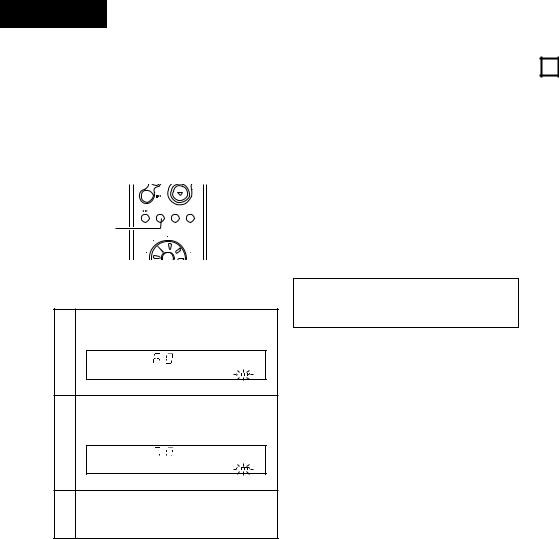
ENGLISH
(5) Timer function
(when connected in a system with the 201SA series)
2The power can be set to turn on and off at a specific time or at the same time everyday, in any modes: tuner (“TUNER”), CD player (“CD”), cassette deck (“TAPE”), MD recorder (“MD”) and timer recording (recording to the cassette deck (“AIRCH”) or the MD recorder (“AIRCH MD”) from the tuner).
(6) Setting the Sleep Timer
2With this function, the power can be set to turn off after 10 to 60 minutes, in steps of 10 minutes, using the remote control unit.
RC-906
(system remote - control unit)
TAPE
SLEEP FUNCTION MODE
1,2
|
CD |
TUNER |
MD |
TAPE |
CD-R |
Example: To turn the power off after 50 minutes. (This operation is only possible from the remote control unit (RC-906).)
Press the SLEEP button.
1
Press the SLEEP button again while the ”SLEEP” indicator is flashing.
2
The previous display reappears after 5 seconds. 3 The “SLEEP” indicator remains lit, indicating
that the sleep timer is functioning.
Cancelling the Sleep Timer
Press the SLEEP button repeatedly until the “SLEEP” indicator turns off.
The sleep timer is also canceled if the power operation switch or the power operation switch on the remote control unit is pressed, turning the system power off.
NOTE:
If a several timer operations are set at once, the sleep timer has priority.
•The time is reset to “60” (60 minutes) if the SLEEP button is pressed again while the sleep timer is functioning.
10 SYSTEM FUNCTIONS
2Operation is even easier when the components in the 201SA series are connected to the DRA-201SA with system connections. (For instructions on connections, refer to “CONNECTIONS” on page 6, 7.)
2All the system function signals for operating the components in the 201SA series are output from the DRA-201SA, so be sure to connect the DRA-201SA when making system connections.
2The system functions will only work when the components of the 201SA series are connected. They will not work with other components.
2When system connections are made, the system functions described below can be used.
(1)The system remote control unit (RC-906) included with the DRA-201SA can be used to perform the main operations on the other components.
(2)The remote control signals of the other components are received by the DRA-201SA’s remote sensor.
(3)Auto power on function:
When the system is set to the standby mode, the power turns on automatically when the PLAY/PAUSE button ( 1 3) on the CD player (DCD-201SA), cassette deck (DRR-201SA), and MD recorder (DMD-201SA) is pressed, and playback begins.
(4)Auto function selection:
The function automatically switches when the PLAY/PAUSE button ( 1 3) on the CD player (DCD-201SA), cassette deck (DRR-201SA), and MD recorder (DMD-201SA) is pressed, and playback begins.
(5)CD synchronized recording:
CDs can be recorded on the cassette deck (DRR-201SA), MD recorder (DMD-201SA) simply by pressing the CD SRS button on the cassette deck.
(6)Simultaneous recording:
When the PLAY/PAUSE button ( 1 3) on the CD player (DCD-201SA) is pressed while the cassette deck (DRR201SA), MD recorder (DMD-201SA) is set to the recording pause mode, recording starts automatically.
(7)Timer functions:
The timer functions on the stereo receiver (DRA-201SA) can be used to start playback or record radio programs (“air check”) at set times. The sleep timer can also be used.
2For instructions on the various operations, refer to the components’ operating instructions.
18

ENGLISH
11 TROUBLESHOOTING
Check the following before assuming there is a problem with the set.
1.Are all connections proper ?
2.Is the set being operated as described in the operating instructions ?
3.Are the speakers and input components being operated properly ?
If the set does not seem to be operating properly, check the points listed below. If these points do not apply, the set may be damaged. Turn off the power immediately and contact your store of purchase.
Symptom |
|
Cause |
|
|
Remedy |
page |
|
|
|
|
|
||||
POWER LED does not |
• Power supply cord is not connected. |
• Check that the cord is plugged in. |
6, 8 |
||||
light and no sound is |
|
|
|
|
|
|
|
produced when POWER |
|
|
|
|
|
|
|
switch is turned on. |
|
|
|
|
|
|
|
|
|
|
|
|
|
|
|
|
• Speaker |
cords |
not |
properly |
• Connect securely. |
6, 7 |
|
POWER LED lights but no |
connected. |
|
|
|
|
|
|
• INPUT SELECTOR not set to proper |
• Set to the proper position. |
12 |
|||||
sound is produced. |
|||||||
position. |
|
|
|
|
|
||
|
|
|
|
|
|
||
|
• VOLUME control turned down. |
• Set to an appropriate level. |
12 |
||||
|
|
|
|
||||
|
• Speaker cords not properly con- |
• Connect securely. |
7 |
||||
Sound is not produced |
nected. |
|
|
|
|
|
|
• Input cords not properly connected. |
• Connect securely. |
6 |
|||||
from one side only. |
|||||||
• Left/right |
balance improperly |
|
|
||||
|
|
|
|||||
|
adjusted. |
|
|
|
• Adjust the BALANCE control. |
13 |
|
|
|
|
|
|
|
|
|
Volume level is different |
• Tuner and record outputs different. |
• Adjust the tuner output to the |
— |
||||
|
|||||||
when listening to tuner |
|
|
|
|
turntable’s output (if the tuner is |
|
|
and records. |
|
|
|
|
equipped with an output control). |
|
|
|
|
|
|
||||
Positions of instruments |
• Left and right speakers or input |
• Check the left/right connections. |
6, 7 |
||||
inverted for stereo sources. |
cords inverted. |
|
|
|
|
||
|
|
|
|
||||
|
• Is the antenna cable properly |
• Connect the antenna cable properly. |
5 |
||||
|
connected? |
|
|
|
|
|
|
Hissing noise is heard |
• Is there interference from an |
• Change the position of the |
5, 6, 7 |
||||
when an FM station is |
electronic device equipped with a |
equipment or change the position or |
|
||||
tuned in. |
microprocessor, or is the signal of |
direction of the connection cords and |
|
||||
|
the FM station weak? |
|
antenna. |
|
|||
|
|
|
|
|
• Connect an outdoor antenna. |
5 |
|
|
|
|
|
||||
Scratchy or hissing noise |
• Is there interference from a TV set, |
• Turn off the TV. |
— |
||||
or interference |
from |
another |
• Change the position or direction of |
5 |
|||
is heard when an AM |
|||||||
broadcast station? |
|
|
the AM antenna. |
|
|||
station is tuned in. |
|
|
|
||||
|
|
|
|
• Connect an outdoor antenna. |
5 |
||
|
|
|
|
|
|||
|
|
|
|
||||
Humming noise is heard |
• Is the signal carried over the power |
• Insert the power plug in the opposite |
— |
||||
when an AM station is |
cord being modulated by the power |
direction. |
|
||||
tuned in. |
supply frequency? |
|
|
• Connect an outdoor antenna. |
5 |
||
|
|
|
|
|
|
|
|
Symptom |
Cause |
Remedy |
page |
|
|
|
|
|
|
|
• Turntable’s ground wire not |
• Connect securely. |
6 |
|
|
connected. |
|
|
|
Booming sound produced |
• Input cords not properly connected |
• Connect securely. |
6 |
|
when playing records. |
to PHONO terminals. |
|
|
|
|
• Influence from a TV or other |
• Change the position of installation. |
— |
|
|
electrical device near the turntable. |
|
|
|
|
|
|
|
|
|
• Turntable and speaker systems are |
• Move speaker systems as far away |
— |
|
|
too close. |
as possible. |
|
|
Howling produced when |
• Floor is soft and vibrates easily. |
• Use cushions to absorb the |
— |
|
volume is turned up while |
|
vibrations transmitted from the floor |
|
|
playing records. |
|
to the speakers. If the turntable does |
|
|
|
|
not include insulators, use audio |
|
|
|
|
insulators, available in stores. |
|
|
|
|
|
|
|
|
• Stylus pressure is too light. |
• Apply proper pressure. |
— |
|
Sound is distorted. |
• Dirt on tip of stylus. |
• Check the tip of the stylus. |
— |
|
|
• Defective cartridge. |
• Replace the cartridge. |
— |
|
|
|
|
|
|
|
• Batteries dead. |
• Replace with new batteries. |
9 |
|
|
• Remote control unit too far from this |
• Move closer. |
10 |
|
This unit does not operate |
unit. |
|
|
|
• Obstacle between this unit and |
• Remove obstacle. |
10 |
||
properly when remote |
||||
remote control unit. |
|
|
||
control unit is used. |
|
|
||
• Different button is being pressed. |
• Press the proper button. |
10 |
||
|
||||
|
• < and > ends of battery inserted in |
• Insert batteries properly. |
9 |
|
|
reverse. |
|
|
|
|
|
|
|
19

ENGLISH
12 SPECIFICATIONS
2 |
POWER AMPLIFIER SECTION |
|
|
|
|
|
|
|
|
Rated Output Power: |
50 W + 50 W (4 Ω /ohms, DIN, 1 kHz, T.H.D. 0.7%) |
||||||
|
Output terminals: |
4 to 16Ω |
/ohms |
|
|
|
||
• |
PRE AMPLIFIER SECTION |
|
|
|
|
|
|
|
|
Rated Output: |
150 mV (Recout Terminal) |
|
|||||
|
Input Sensitivity/ |
|
|
|
|
|
|
|
|
Input Impedance: |
|
|
|
|
|
|
|
|
|
PHONO: |
|
|
|
2.5 mV/47 kΩ |
/kohms |
|
|
|
CD, DVD/AUX, |
|
|
|
|
||
|
|
TAPE, MD, AUX-2: |
100 mV/16 kΩ |
/kohms |
||||
|
RIAA Deviation: |
PHONO: |
|
|
|
20 Hz to 20 kHz ±0.5 dB |
||
• |
OVERALL CHARACTERISTICS |
|
|
|
|
|
|
|
|
SN Ratio (IHF A Network): |
PHONO: 80 dB (at 5 mV input) (input terminals short-circuited) |
||||||
|
|
CD, DVD/AUX, |
|
|
|
|
||
|
|
TAPE, MD, AUX-2: 102 dB (SOURCE DIRECT: ON) |
||||||
|
Frequency Response: |
5 Hz to 80 kHz : +0, –3 dB (SOURCE DIRECT: ON) |
||||||
|
Tone Control Adjustable Range: |
BASS: |
|
100 Hz ±8 dB |
|
|||
|
|
TREBLE: |
10 kHz ±8 dB |
|
||||
|
|
LOUDNESS: 100 Hz +8 dB |
|
|||||
|
|
|
|
|
10 kHz +6 dB |
|
||
2 |
TUNER SECTION |
|
|
|
|
|
|
|
|
Reception frequency range: |
FM |
: |
87.50 MHz ~ 108.00 MHz |
|
|||
|
|
AM |
: |
522 kHz ~ 1611 kHz |
|
|||
|
Practical sensitivity: |
FM |
: |
1.2 µV/75 Ω |
/ohms (12.8 dBf) |
|
||
|
|
AM |
: |
18 µV |
|
|
|
|
|
FM stereo isolation: |
40 dB (1 kHz) |
|
|
|
|
||
|
FM S/N ratio: |
Monaural: 77 dB |
|
Stereo: 71 dB |
|
|||
|
FM harmonic distortion: |
Monaural: 0.3% |
|
Stereo: 0.4% |
|
|||
|
Timer functions: |
Everyday timer |
(1 setting) |
|
||||
|
|
Once timer |
|
(1 setting) |
|
|||
|
|
Sleep timer |
|
(maximam 60 min.) |
|
|||
• |
OTHERS |
|
|
|
|
|
|
|
|
Power Supply: |
AC 230 V, 50 Hz |
|
|
|
|||
|
Power Consumption: |
110 W |
|
|
|
|
|
|
|
|
(Approx. 1W in standby mode) |
|
|||||
|
Dimensions: |
250 (W) X 90 (H) X 371 (D) mm |
|
|||||
|
Mass: |
6.2 kg |
|
|
|
|
|
|
• |
REMOTE CONTROL UNIT (RC-906) |
|
|
|
|
|
|
|
|
Remote control system: |
Infrared pulse system |
|
|||||
|
Power supply: |
3 V DC, Two size R03 (“AAA”) |
|
|||||
|
|
dry cell batteries |
|
|
|
|||
|
External dimensions: |
48 (W) X 210 (H) X 29 (D) mm |
|
|||||
|
Mass: |
120 g |
|
|
|
|
|
|
|
|
(including batteries) |
|
|
||||
• |
For improvement purposes, specifications and functions are subject to change without advanced notice. |
|||||||
20
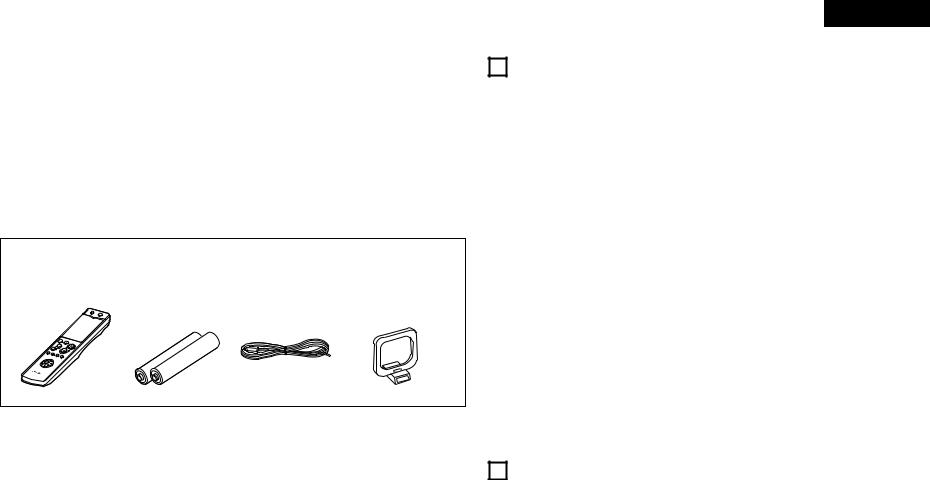
INHALT
z HAUPTMERKMALE ………………………………… 21 |
m BETRIEB ………………………………………… 29, 30 |
x VOR INBETRIEBNAHME …………………………… 21 |
, RADIO HÖREN ………………………………… 30~32 |
c ANSCHLUSS DER ANTENNEN …………………… 22 |
. VERWENDUNG DES TIMERS ……………… 33~35 |
v ANSCHLÜSSE …………………………………… 23, 24 |
⁄0SYSTEMFUNKTIONEN ……………………………… 35 |
b BAUTEILBEZEICHNUNGEN |
⁄1FEHLERSUCHE ……………………………………… 36 |
UND FUNKTIONEN ……………………………… 25, 26 |
⁄2TECHNISCHE DATEN ……………………………… 37 |
n SYSTEMFERNBEDIENUNG …………………… 26~28 |
|
2ZUBEHÖRS
Stellen Sie sicher, daß die nachfolgend aufgeführten Zubehörteile dem Hauptgerät beiliegen:
q Fernbedienungsgerät (RC-906) ………………………1 |
r MW-Raumantenne ……………………………………1 |
w R03 (AAA)-Batterien ……………………………………2 |
t Betriebsanleitung ………………………………………1 |
e UKW-Antennenadapter ………………………………1 |
y Kundendienstverzeichnis ……………………………1 |
q |
w |
e |
r |
|
++ |
|
|
|
-- |
|
|
1HAUPTMERKMALE
1.HC-TR-Ausgangsschaltung für Feinheit und Leistung
Eine einfache Gegentaktschaltung mit einem HC-TR (Starkstrom-Transistor), der auf den gleichen Prinzipien basiert wie das UHC-MOS im POA-S1, dem erstklassigen monauralen Leistungsverstärker von DENON, erzielt eine stabile Starkstromversorgung und eine exzellente Kleinsignallinearität. Das Ergebnis ist ein hoher Grad an Feinheit und Leistung.
2.Die leistungsfähige Starkstromschaltung unterstützt die ausdrucksstarken Fähigkeiten der HC-TR-Ausgangsschaltung
Die leistungsfähige Starkstromschaltung besteht aus Hochleistungs-Gleichrichterdioden und großen Tonqualitätsblock-Kondensatoren, die dafür sorgen, dass sich das maximale Potential der HCTransistorausgangsschaltung entfalten kann.
3.S.L.D.C.
Beim DRA-201SA kommt die S.L.D.C. (Signal Level Divided Construction) für die Trennung der unterschiedlichen Schaltungen zum Einsatz (Kleinsignalschaltung, Großsignalschaltung, Mikroprozessorschaltung, usw.)
4.Quellen-Direktfunktion für bessere Tonqualität
Der DRA-201SA ist mit einer Quellen-Direktfunktion ausgestattet, die den Tiefen-, Höhen-, Loudnessund Balance-Schaltkreis umleitet, um einen einzigen Signalweg zu erhalten, der dafür sorgt, dass der Ton klar bleibt.
DEUTSCH
5.Kompatibel mit RDS
Kompatibel mit verschiedene RDS-Services, einschließlich Programmservicenamen (PS), Programmsparten-Identifikation (PTY), Verkehrsprogramm-Identifikation (TP), Uhrzeit (CT) und Radiotextmeldungen (RT).
6.MW/UKW-Tuner mit Zufallsvoreinstellungsfunktion für 40 Sender
7.System-Fernbedienungsgerät
Der DRA-201SA ist mit einem SystemFernbedienungsgerät ausgestattet, das für die Steuerung der verschiedenen Komponenten innerhalb der 201SA-Reihe (CD-Player, MD-Recorder und Kassettendeck bei Verwendung mit Systemanschluss) verwendet werden kann.
8.Niedriger Stromverbrauch im Bereitschaftsbetrieb
Der Stromverbrauch im Bereitschaftsbetrieb wird auf 1 W oder weniger reduziert.
2 VOR INBETRIEBNAHME
Beachten Sie vor der Inbetriebnahme des Gerätes die |
• Bewahren Sie diese Betriebsanleitung an einem |
nachfolgend aufgeführten Hinweise: |
sicheren Ort auf. |
• Transport des Gerätes |
Bewahren Sie diese Betriebsanleitung nach dem |
Um sowohl Kurzschlüsse als auch eine Beschädigung |
Durchlesen zusammen mit der Garantiekarte an einem |
der Drähte in den Anschlußkabeln zu vermeiden, |
sicheren Ort auf. |
müssen vor einem Transport des Gerätes sowohl das |
• Beachten Sie bitte, daß die Abbildungen in dieser |
Netzkabel als auch alle Anschlußkabel zwischen den |
Betriebsanleitung für Erklärungszwecke vom |
einzelnen Audio-Komponenten abgetrennt sein. |
aktuellen Gerätemodell abweichen können. |
• Vor dem Einschalten des Netzschalters |
|
Vergewissern Sie sich noch einmal, daß alle |
|
Anschlüsse richtig ausgeführt worden sind und es |
|
keinerlei Probleme mit den Anschlußkabeln gibt. |
|
Stellen Sie den Netzschalter vor dem Anschließen bzw. |
|
Abtrennen von Anschlußkabeln stets auf die Standby- |
|
Position. |
|
21
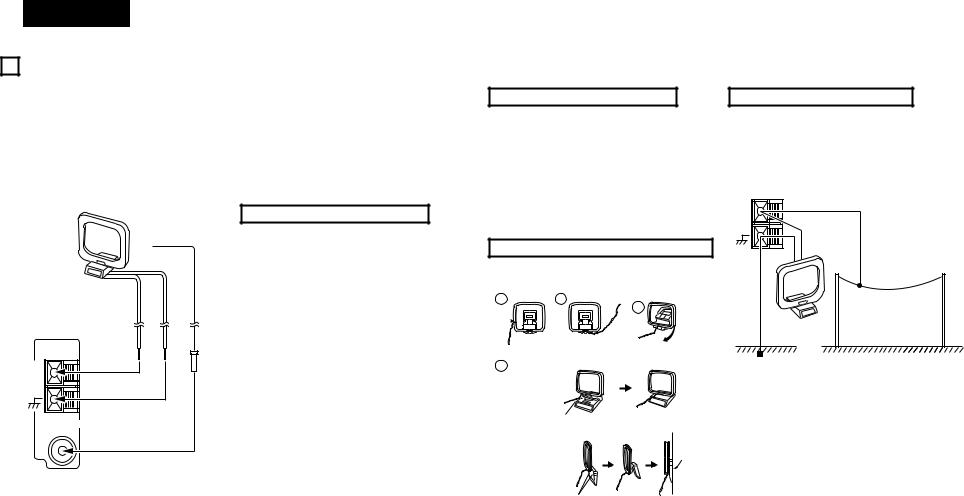
DEUTSCH
3 ANSCHLUSS DER ANTENNEN
Montage der UKW-Zimmerantenne |
|
Anschluß an UKW-Außenantenne |
|
Stellen en Sie einen UKW-Sender ein (Siehe seite 30), |
Wenn sich mit der mitgelieferten UKW-Antenne kein |
||
richten Sie die Antenne so aus, daß Tonverzerrungen und |
einwandfreier Empfang erzielen läßt, muß das Gerät an |
||
Störgeräusche möglichst gering ausfallen, und fixieren Sie |
eine UKW-Außenantenne angeschlossen werden. |
||
dann die Spitze der Antenne mit Klebeband oder einer |
Verbinden Sie einen Winkelstecker des IEC-Typs mit dem |
||
Haftzwecke in dieser Position. |
Koaxialkabel, und schließen Sie die Antenne an dem |
||
|
|
Eingang FM COAX (75Ω /Ohm) an. |
|
MW-Rahmenantenne
UKW-Antenne
AM
LOOP
ANT.
Montage der UKW-Außenantenne
•Richten Sie die Antenne auf die Sendeantenne des Senders aus. Wenn sich hohe Gebäude oder Berge zwischen der Empfangsund der Sendeantenne befinden, variieren Sie Standort bzw. Ausrichtung der Antenne, bis Sie die bestmögliche Einstellung gefunden haben.
•Antenne nicht unter Hochspannungsleitungen errichten. Bei Berührung der Hochspannungsleitungen mit der Antenne besteht Lebensgefahr.
•Antenne möglichst weit entfernt von Strßen bzw. Eisenbahnlinien montieren, um Störeinflüsse zu vermeiden.
•Antenne nicht zu hoch installieren, um Blitzeinschlag zu vermeiden.
ANTENNA FM COAX. 75
Montage der MW-Rahmenantenne
Stellen Sie einen MW-Sender ein (Siehe seite 30), und richten Sie die Antenne in möglichst großer Entfernung vom Gerät so aus, daß Tonverzerrungen und Störgeräusche möglichst geringt ausfallen. In manchen Fällen empfiehlt es sich, die Polung der Antenne umzukehren. MW-Sender lassen sich nicht in zufriedenstellender Qualität empfangen, wenn keine Rahmenantenne angeschlossen ist oder wenn diese sich zu nahe an metallenen Gegenständen befindet.
Zusammenbau der MW-Rahmenantenne
Schließen Sie an den MW-
Antennenanschlüssen an.
1 |
2 |
3
Entfernen Sie den Plastikbinder und ziehen Sie die Verbindungsleitung
4auseinander.
a.Mit der Antennenach
oben auf eine ebene Fläche
Stellen
b.Montage der Antenne an der Wand.
Biegen Sie in
Gegenrichtung.
Mittels den Installationsbohrungen an der Wand, etc. befestigen
Montage der MW-Außenantenne
Verbinden Sie den Signalleiter der MW-Außenantenne mit
dem Antennenanschluß. Verbinden Sie den Leiter für die
Signalerde mit dem  -Anschluß. Schließen Sie darüber
-Anschluß. Schließen Sie darüber
hinaus auch die mitgelieferte MW-Rahmenantenne an.
AM
LOOP
ANT.
MW-Rahmenantenne MW-Außenantenne
Signalerde
22
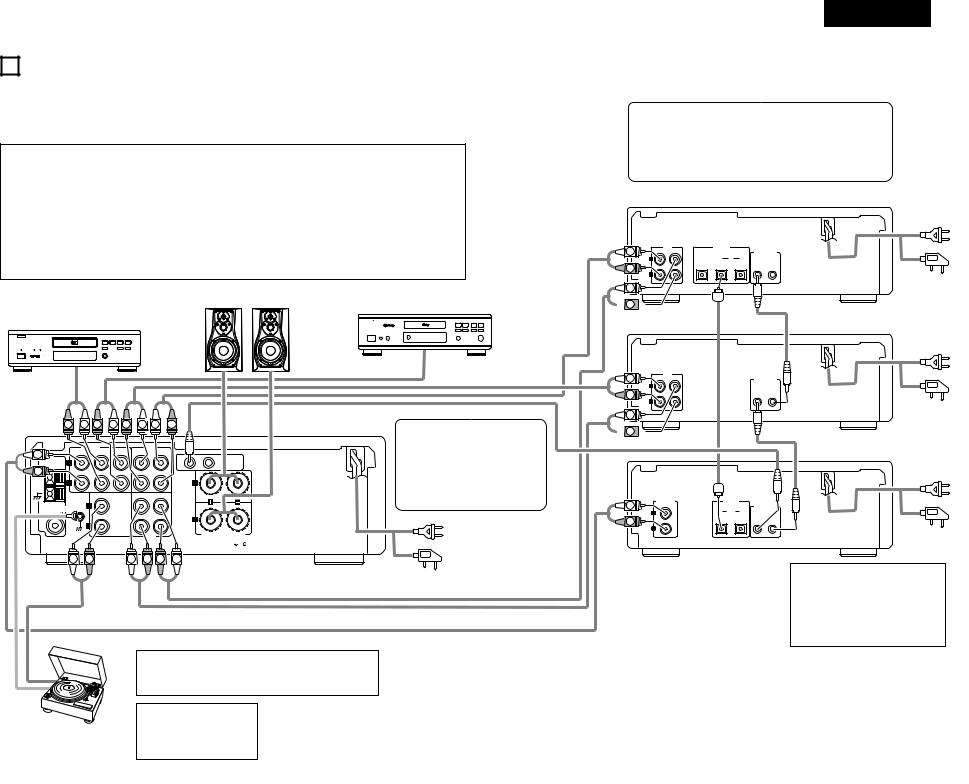
4 ANSCHLÜSSE
2Beziehen Sie sich beim Ausführen der Anschlüsse ebenfalls auf die Bedienungsanleitungen der anderen Komponenten.
2Wenn ein Anschluss an die 201SA-Serie erfolgt, nehmen Sie die im Diagramm unten durch gepunktete Linien gekennzeichneten Systemanschlüsse vor.
2Der DRA-201SA wird nicht mit Anschlusskabeln geliefert. Die den Komponenten beiliegenden Anschlusskabel für den Anschluss des DRA-201SA verwenden.
HINWEISE:
•Stecken Sie das Netzkabel erst dann ein, nachdem alle Verbindungen beendet sind.
•Stellen Sie sicher, daß der linke und rechte Kanal richtig verbunden wurde (links mit links, rechts mit rechts).
•Achten Sie auf sichere Steckverbindungen. Schlechte Kontakte verursachen Störungen.
•Beachten Sie bitte, daß durch das Zusammenbinden von Steckverbindungen mit dem Netzkabel oder wenn diese in der Nähe des Netztransformators geführt werden, Brummen oder andere Störungen erzeugt werden können.
•Die PHONO-Anschlußklemmen haben eine außergewöhnlich hohe Empfindlichkeit. Vermeiden Sie daher das Erhöhen der Lautstärke, wenn keine Stiftsteckerkabel angeschlossen sind. Andernfalls kann es zu einem Induktionsbrummen (dröhnen) von den Lautsprechern kommen.
•Der Ton einer anderen Komponente kann gehört werden, wenn keine Komponente an die Eingangsbuchsen der mit dem FUNCTION-Wähler eingestellten Funktion angeschlossen ist.
Lautsprechersystem
CD-Spieler
DVD-Spieler
B
(L) |
(R) |
R |
L |
|
|
L |
R |
|
ANT. |
R |
L |
R |
L |
R |
L |
L |
R |
INPUTS |
TAPE |
PB |
|
|
CD DVD/AUX AUX-2 |
MD |
2 |
|
|
|
|
1 |
SYSTEM |
|
|
|
|
|
CONNECTOR |
|
|
|
L |
|
PHONO |
TAPE |
MD |
|
|
•Der Stereo-Receiver der 201SAReihe (DRA-201SA) ist mit einer Uhrund Timerfunktion ausgestattet; stellen Sie aus diesem Grund sicher, dass er an eine Wandsteckdose angeschlossen wird, die fortwährend mit Strom versort ist.
L
ANTENNA
FM COAX. 75
R |
Netzstecker |
|
R |
|
|
Wechselstrom 230 V, 50 Hz |
|
SIGNAL |
REC |
SPEAKER SYSTEM |
|||
(In die Netzsteckdose stecken) |
|||||
GND |
SPEAKER IMPEDANCE |
||||
|
|
4 |
16 |
|
|
L |
R |
L |
R R |
L |
Netzkabel |
|
(für die U.K.-Modell) |
||||||
|
|
|
|
|
Plattenspieler (MM-Tonabnehmer)
HINWEIS:
Dieses Gerät kann nicht direkt mit MM-Tonabnehmern benutzt werden. Verwenden Sie einen Hauptverstärker oder Aufwärtstransformator mit MC-Tonabnehmern.
HINWEIS:
•Schließen Sie die Erdungsleitung an. Trennen Sie sie jedoch wieder ab, wenn Brummen oder andere Geräusche auftreten.
DEUTSCH
•Schließen Sie beim Ausführen von Systemanschlüssen an die 201SA-Serie das Systemkabel an den Systemanschluss des DRA201SA (1 oder 2) an. Schalten Sie andere Systemkomponenten auf die gleiche Weise zusammen.
(Systemanschlüsse sind im Diagramm durch gepunktete Linien gekennzeichnet.)
MD-Rekorders
(DMD-201SA)
L |
|
LINE |
OUT |
IN |
|
|
L |
OUT |
|
|
|
R |
|
|
|
R |
|
L |
 R
R 
Cassettendeck
(DRR-201SA)
L |
|
LINE |
OUT |
IN |
L |
R |
R |
L |
 R
R 
DIGITAL |
|
|
|
|
OPTICAL |
|
|
|
SYSTEM |
1 |
IN |
2 |
CONNECTOR |
|
|
|
|||
|
|
|
1 |
2 |
SYSTEM
CONNECTOR
1 2
CD-Spieler (DCD-201SA)
L |
LINE OUT |
DIGITAL |
|
|
|
OPTICAL |
|
SYSTEM |
|
L |
1 |
OUT |
2 |
CONNECTOR |
R |
1 |
2 |
|
|
|
|
R |
|
Netzstecker
Wechselstrom 230 V, 50 Hz
(In die Netzsteckdose stecken)
Netzkabel
(für die U.K.-Modell)
Netzstecker
Wechselstrom 230 V, 50 Hz
(In die Netzsteckdose stecken)
Netzkabel
(für die U.K.-Modell)
Netzstecker
Wechselstrom 230 V, 50 Hz
(In die Netzsteckdose stecken)
Netzkabel
(für die U.K.-Modell)
HINWEIS:
•Stellen Sie keine weitere Komponente oder einen anderen Gegenstand direkt auf den DRA201SA, damit Hitze entweichen kann.
23
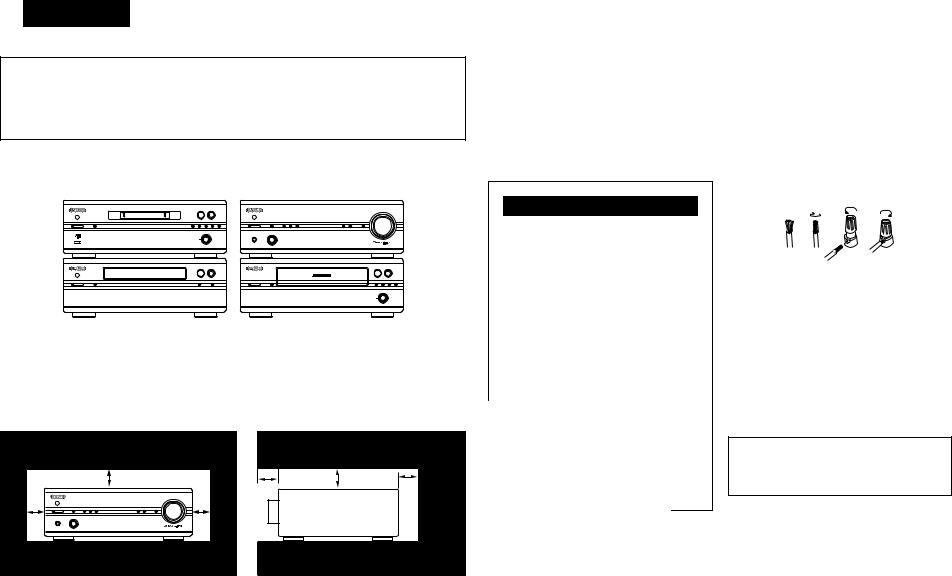
DEUTSCH
Systemfunktionen
•Systemfunktionen wie die Timer-Aufnahme/Wiedergabe und autom. Funktionseinschaltung können nur aktiviert werden, wenn Stereoaudiokabel und Systemkabel zwischen allen Systemkomponenten angeschlossen werden. Vergewissern Sie sich, dass alle Anschlusskabel zwischen den Einheiten fest angeschlossen sind.
•Wenn ein Systemkabel während des Betriebs abgezogen wird, kann eine Fehlfunktion auftreten. Ziehen Sie unbedingt die Netzkabel ab, bevor Anschlussänderungen vorgenommen werden.
2Empfohlene Systeminstallation
• Installieren Sie das System (201SA-Serie) wie unten beschrieben, um Leistung und Stabilität zu gewährleisten.
1 3 |
2 |
VOLUME |
5 |
|
|
(DMD-201SA) |
(DRA-201SA) |
+ |
MHz CH |
TUNED STEREO |
AUTO |
MINIDISC RECORDER DMD-201SA |
STEREO RECEIVERER DRA-201SA |
1 3 |
2 |
1 |
2 |
C |
|
|
|
55
(DCD-201SA) |
(DRR-201SA) |
L |
|
dB |
|
R |
+ |
3 |
DOLBY NR B |
COMPACT DISC PLAYER DCD-201SA |
STEREO CASSETTE TAPE DECK DRR-201SA |
Stellen Sie keine andere Komponente direkt auf den DRA-201SA. Lassen Sie mindestens 10 cm über dem DRA201SA Platz, damit die Ventilationsöffnungen nicht blockiert werden und Hitze entweichen kann.
Stapeln Sie aus Stabilitätsgründen nicht mehr als drei Komponenten übereinander.
Zur Gewährleistung einer ausreichenden Wärmeabfuhr, sollte oberhalb, seitlich sowie hinter dem Gerät ein Mindestabstand von 10 cm zur Wand oder zu anderen Komponenten eingehalten werden.
|
10 cm oder mehr |
|
|
|
|
|
|
5 cm |
|
|
|
|
|
|
|
|
VOLUME |
|
|
|
|
|
|
|
|
MHz |
CH |
|
|
TUNED STEREO |
AUTO |
|
|
|
|
|
STEREO RECEIVERER DRA-201SA |
|
|
•Umschalten der Eingangsfunktion, wenn keine Eingangsbuchsen angeschlossen sind
Wenn die Eingangsfunktion umgeschaltet wird, wenn nichts an die Eingangsbuchsen angeschlossen wurde, ist möglicherweise ein Klicken zu hören. Drehen Sie in einem derartigen Fall entweder den MASTER VOLUME-Regler herunter oder schließen Sie Komponenten an die Eingangsbuchsen an.
Trennen Sie unbedingt das Netzkabel ab, wenn Sie für einen längeren Zeitraum, z.B. im Urlaub, nicht zuhause sind.
Lautsprechersystem-Anschlüsse
2 Lautsprecherimpedanz
Verwenden Sie Lautsprechersysteme mit einer Impedanz von 4 bis 16Ω /Ohm.
•Beachten Sie, dass die Verwendung von Lautsprechern mit einer anderen Impedanz die Schutzschaltung aktiviert und dadurch Schäden verursacht werden können.
Schutzschaltung
Dieses Gerät ist mit einer Hochgeschwindigkeits-Schutzschaltung versehen.
Diese Schaltung dient zum Schutz der inneren Schaltungen, die sonst leicht beschädigt werden können, wenn die Lautsprecherklemmen nicht vollständig angeschlossen sind, oder wenn ein Ausgang durch einen Kurzschluß generiert wird. Bei Einsatz dieser Schutzschaltung wird der Ausgang zu den Lautsprecher abgeschnitten. Sehen Sie in diesem Falle zu, daß der Netzanschluß des Gerätes abgeschaltet wird, und daß die Anschlüsse zu den Lautsprechern überprüft werden.
Schalten Sie den Netzanschluß dann wieder ein. Nach der mehrere Sekunden lang dauernden Stummschaltung funktioniert das Gerät wieder normal.
2 Anschließen der Lautsprecherkabel
q Streifen Sie die Mantelung vom Ende des Kabels ab. w Drehen Sie die Kabeladern.
eDrehen Sie die Lautsprecherklemme entgegen des Uhrzeigersinns, um sie zu lösen.
rSetzen Sie die Kabeladern vollständig ein und drehen Sie die Klemme dann im Uhrzeigersinn, um sie wieder zu befestigen.
q w e r
BAchten Sie darauf, daß Sie die Kabel zwischen den Lautsprecherklemmen und den Lautsprechersystemen mit den gleichen Polaritäten (< an <, > an >) anschließen. Andernfalls ist der Mittelklang schwach und die Position der verschiedenen Instrumente ist undeutlich. Dies verringert den Stereo-Effekt.
BAchten Sie beim Anschließen der Lautsprecher darauf, daß die Kabeladern nicht aus den Klemmen herausragen und andere Klemmen, sich gegenseitig oder die Rückseite des Gerätes berühren.
HINWEIS:
•Berühren Sie die Lautsprecherklemmen NIEMALS, wenn der Strom eingeschaltet ist. Dies könnte einen elektrischen Schlag verursachen.
24
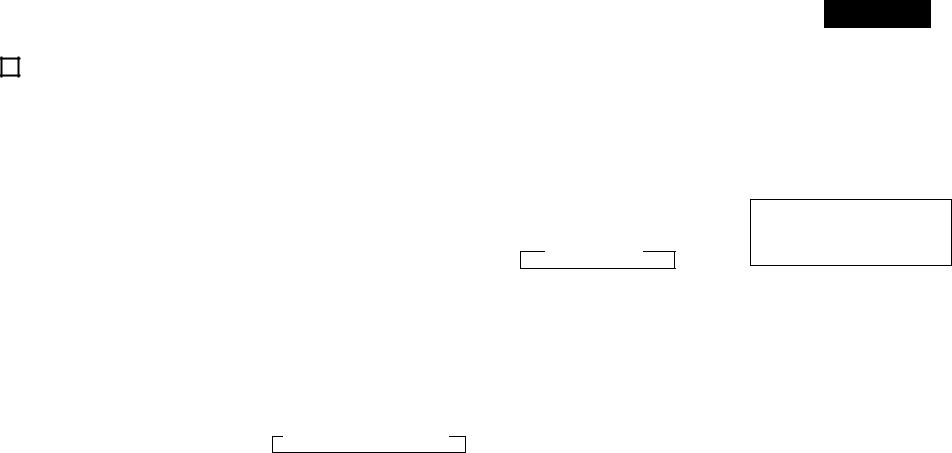
5 BAUTEILBEZEICHNUNGEN UND FUNKTIONEN
(1) Frontplatte
qNetzschalter (ON/STANDBY)
•Mit diesem Schalter wird das komplette System einbzw, ausgeschaltet.)
•Drücken Sie diesen Schalter einmal, um das System einzuschalten, und nochmals, um es in den Bereitschaftsmodus (STANDBY) zu schalten.
•Die Farbe der LED wechselt je nach Betriebszustand:
Gerät eingescnaltet: grün
Im Bereitschaftsmodus (STANDBY): rot
Im Timer-Bereitschaftsmodus (TIMER
STANDBY): orange
Der Stummschaltungsbetrieb wird aktiviert, wenn die Netztaste des Hauptgerätes gedrückt und wenn der Standby-Betrieb mithilfe der Fernbedienung beendet wird. Die LED blinkt im Stummschalt-Modus, beendet dann das Blinken und bleibt erleuchtet, wenn das Gerät betriebsbereit ist.
Wenn die Anzeige orange blinkt (schnell): Die Schutzschaltung wird aktiviert.
Wenn die geschieht, müssen Sie das Netzkabel abtrennen, damit die Anzeige ausgeschaltet wird; anschließend sind die Eingangsund Ausgangsanschlüsse auf der Rückseite zu überprüfen. Überprüfen Sie insbesondere, ob ein Kurzschluss an den Lautsprecherkabeln
aufgetreten ist. Wenn alle Anschlüsse auf ihre Ordnungsmäßigkeit hin überprüft worden sind, können Sie das Netzkabel wieder anschließen. (Warten Sie nach Ausschalten der Stromversorgung mindestens 10 Sekunden, bevor Sie sie wieder einschalten.)
•Wenn das DRA-201SA an ein System der 201SASerie angeschlossen wird, dient die Netztaste als Hauptschalter für das gesamte System. Wenn die Stromversorgung des DRA-201SA eingeschaltet
wird, wird die Stromversorgung aller angeschlossenen Systemkomponenten eingeschaltet.
Der DRA-201SA wird mit Strom versorgt, auch wenn der Bereitschaftsbetrieb aktiviert ist (geringer Stromverbrauch).
wPHONES (Kopfhörerbuchse)
•Hier können Sie ein Paar Kopfhörer (optional erhältlich) anschließen.
•Wenn der Kopfhörerstecker in die Buchse gesteckt wird, wird die Ausgabe über Lautsprecher automatisch deaktiviert, sodass kein Ton von den Lautsprechern produziert wird.
eREMOTE SENSOR (Fernbedienungssensor)
•Dieser Sensor fängt die von der drahtlosen Fernbedienung übermittelten infraroten Lichtstrahlen auf.
Soll eine Fernbedienung durchgeführt werden, ist die drahtlose Fernbedienung direkt auf das Sensorfenster zu richten.
rFunktionswähler (FUNCTION)
•Wechselt die Eingangsfunktion. Damit werden auch die Betriebe eingestellt, die mit der Betriebstaste gewählt wurden.
(Siehe seiten 29, 30.)
tBetriebstaste (MODE)
•Stellen Sie mit dieser Taste den Tiefen-, Höhenund Balancepegel ein.
(Beziehen Sie sich auf seite 29, 30.)
•Schalten Sie mit dieser Taste die LoudnessFunktion ein und aus.
(Beziehen Sie sich auf seite 30.)
•Stellen Sie mit dieser Taste das Lautsprechersystem ein.
(Beziehen Sie sich auf seite 30.)
yTimer-Taste (TIMER)
•Drücken Sie bei eingeschalteter Stromversorgung diese Taste, um die Anzeige zu bestätigen oder zu ändern. Bei jeder Tastenbetätigung wechselt die Anzeige wie folgt.
Frequency |
|
Clock |
|
Timer Standby |
|
|
Uhrzeit: Zeigt die aktuelle Uhrzeit an.
Timer-Bereitschaft: Zeigt den TimerBereitschaftsbetrieb an. Schalten Sie den TimerBereitschaftsbetrieb mit den PRESET/TUNINGTasten ein und aus (Siehe seite 34).
•Drücken Sie diese Tasten für mindestens 3 Sekunden (Siehe seite 33), um den Timer einzustellen oder den Timer-Inhalt zu bestätigen (Siehe seite 34).
Bei jeder Betätigung der PRESET/TUNING-Taste wechselt das Display wie folgt:
|
|
TIME |
|
EVERYDAY |
|
ONCE |
|
|
|
|
|
|
|||
|
|
|
|
|
|
|
|
TIME: |
Stellen Sie hiermit die Uhrzeit ein. |
||||||
EVERYDAY: Stellen Sie hiermit den täglichen
|
Timer ein. |
ONCE: |
Stellen Sie hiermit den Timer für eine |
|
einmalige Verwendung ein. |
•Drücken Sie im BEREITSCHAFTSBETRIEB diese Taste, um die Uhrzeitanzeige EIN- /AUSZUSCHALTEN “Energiesparbetrieb”).
uBand/RDS-Taste (BAND/RDS)
•Wechseln der Frequenzbereichsund der UKWEmpfangsmodus folgendermaßen:
|
FM AUTO |
|
FM MONO |
|
AM |
|
|
|
|
|
|||
|
|
|
|
|
|
|
•Drücken Sie bei eingestelltem UKW-Band diese Taste für mindestens 3 Sekunden, um die RDSSuchbetriebe auszuwählen
Bei jeder Tastenbetätigung wechselt die Anzeige wie folgt.
RDS |
|
PTY |
|
TP |
|
|
DEUTSCH
(2) Rückwand
!3 UKW-Antennenanschluss (ANTENNA TERMINAL FM)
• Schließen Sie die UKW-Antenne hier an.
!4 SIGNAL GND (Erdungsklemme)
•Schließen Sie die Erdungsleitung des Plattenspielers hier an.
HINWEIS:
•Diese Anschlußklemme dient zur Reduzierung von Störungen, wenn ein Plattenspieler o.ä. angeschlossen worden ist; sorgt jedoch nicht für eine komplette Erdung.
iSpeicher-/Einstelltaste (MEMORY/SET)
•Verwenden Sie diese Taste als Speichertaste, wenn MWund UKW-Sender voreingestellt werden.
•Verwenden Sie diese Taste als Einstelltaste, wenn die Uhrzeit und der Timer eingestellt und Daten eingegeben werden.
•Drücken Sie bei aktiviertem PTY-Suchbetrieb diese Taste, um die Programmsparte auszuwählen.
•Drücken Sie diese Taste für mindestens 3 Sekunden, um die Funktion der RESET/TUNINGTasten zu wechseln (Voreinstellbetrieb oder Abstimmbetrieb).
o Display
Beziehen Sie sich auf seite 26.
!0 Voreinstell-/Abstimmtasten
(PRESET/TUNING UP und DOWN)
•Rufen Sie mit diesen Tasten voreingestellte Sender auf. (PRESET UP DOWN) (Siehe seite 31.) Stimmen Sie mit diesen Tasten MWund UKWSender ab. (TUNING UP/DOWN)
(Siehe seite 30.)
!1 Source direct button (SOURCE DIRECT)
•Die Regler (BASS, TREBLE, LOUDNESS und BALANCE) können betätigt werden, wenn sich dieser Schalter in der Position OFF befindet.
•Befindet sich der Schalter auf der Position ON,
werden die oben aufgeführten Regler umgangen und die Signale werden direkt zur Lautstärkeregler-Steuerung eingegeben. Dies garantiert einen hochqualitativen Klang.
!2 VOLUME (Lautstärkeregler)
•Dieser Regler dient zur Einstellung der Gesamtlautstärke (Drehgeber-System).
•Rechtsdrehung (,) bewirkt eine Erhöhung, Linksdrehung (.) eine Verringerung der Lautstärke.
•Die Erhöhung bzw. Verringerung der Lautstärke erfolgt in 70 Stufen zwischen dem Mindestwert (VOLUME 0) und dem Höchstwert (VOLUME MAX).
!5 INPUT-Anschlüsse (INPUTS)
Dies sind Eingangsanschlüsse für CD-Player, Plattenspieler, DVD oder andere Wiedergabekomponenten.
• AUX-2:
Schließen Sie hier ein Video Deck oder eine andere Komponente an.
!6 TAPEund MD REC-Anschlüsse (REC)
•Aufnahmeanschlüsse (REC)
•Dies sind Ausgangsanschlüsse für die Aufnahme.
•TAPE:
Schließen Sie hier ein Cassetten Deck an.
• MD:
Schließen Sie hier ein MD-Recorder an.
!7 Netzkabel
•Schließen Sie das Kabel an eine Wandnetzsteckdose an.
!8 Lautsprechersystem-Klemmen (SPEAKER SYSTEM)
• Schließen Sie die Lautsprechersysteme hier an.
!9 Systemanschlüsse
(SYSTEM CONNECTOR 1 und 2)
•Schließen Sie beim Zusammenschluss der 201SASerie zu einem System diese Anschlüsse an die Systemanschlüsse der anderen Systemkomponenten an.
(Verwenden Sie die Systemkabel, die den anderen Komponenten beiliegen.)
@0 TAPEund MD PLAY-Anschlüsse (PB)
• Wiedergabeanschlüsse (PB)
@1 MW-Antennenanschluss (ANTENNA TERMINAL AM)
• Schließen Sie die MW-Antenne hier an.
25
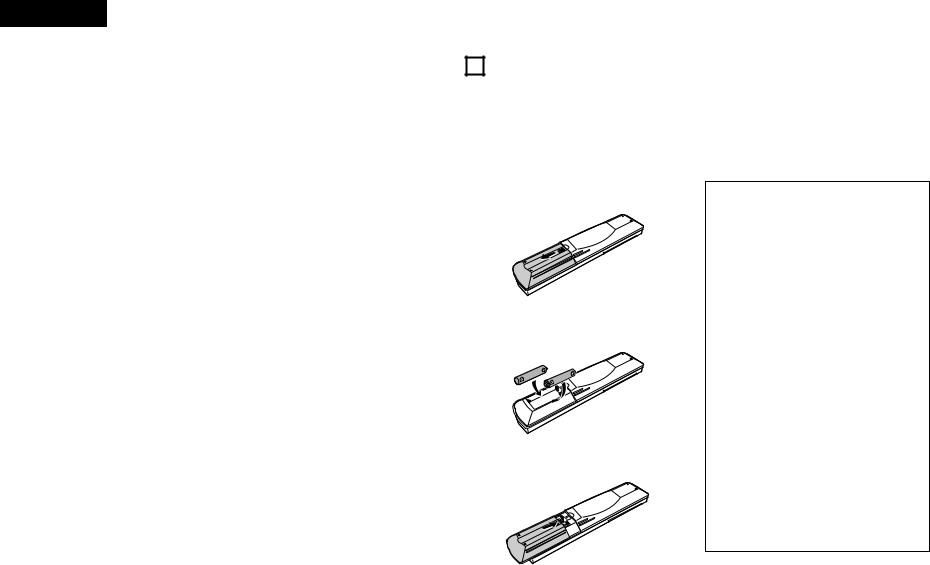
DEUTSCH
(3) Display [o]
@2 Betriebsanzeigen
•Diese zeigen die verschiedenen Betriebsarten an.
• :
:
Leuchtet bei aktiviertem Timer.
• TIME:
Leuchtet auf, wenn das Display auf Uhrzeitmodus geschaltet ist.
• TIMER:
Leuchtet beim Einstellen des Timers sowie bei eingestellter Timer-Funktion.
• ON:
Leuchtet, wenn die Timer-Einschaltzeit eingestellt ist.
• OFF:
Leuchtet, wenn die Timer-Ausschaltzeit eingestellt ist.
• TUNED:
Leuchtet bei einwandfreiem Empfang eines Senders.
• STEREO:
Leuchtet auf, wenn eine Stereosendung in UKW AUTO-Modus empfangen wird.
• MONO:
Leuchtet im AUTO-Modus, wenn ein MonoSender abgestimmt und der MONO-Modus mit der BAND-Taste eingestellt worden ist
• AUTO:
Leuchtet, wenn der AUTO-Modus mit der BAND-Taste eingestellt worden ist.
• MEMO:
Blinkt ca. 10 Sekunden, wenn bei der Senderprogrammierung die MEMORY-Taste gedrückt wird.
• SLEEP:
Leuchtet bei aktiviertem Ausschalt-Timer.
• RDS (Radio Data System):
Bei Betätigung dieser Taste nimmt das Gerät die automatische Suche und Abstimmung des nächsten Senders vor. Zugleich leuchtet die Meldung “RDS” auf, und der Name des Senders erscheint im Display.
• PS (Sendermame):
Diese Meldung leuchtet auf, wenn die Bezeichnung des Senders angezeigt wird.
• TP (Verkehrsfunksender):
Die Meldung “TP” leuchtet auf, wenn ein RDSVerkehrsfunksender empfangen wird.
• PTY (Programmtyp):
Diese Meldung leuchtet auf, wenn ein bestimmter RDS-Programmtyp eingegeben wurde.
• RT (Rundfunktext):
Diese Meldung leuchtet auf, wenn sich das Gerät im RT-Modus befindet und eine RTMeldung eingeht.
@3 Voreinstellnummer-Display
• Hier wird die voreingestellte Nummer angezeigt.
@4 Hauptanzeigebereich
•Hier wird die Funktion, die Eingangsprogrammquelle, usw. angezeigt.
•Während des normalen Betriebs wird die Eingangsprogrammquelle angezeigt.
•Wenn die Betriebstaste gedrückt wird, zeigt die Anzeige die verschiedenen Funktionen an.
•Das Empfangsband, die Empfangsfrequenz, die Uhrzeit, die Timer-Einstellzeiten, usw. werden hier angezeigt.
6 SYSTEMFERNBEDIENUNG
2Mit der beiliegenden Systemfernbedienung (RC-906) können Hauptbedienschritte der durch Systemanschlüsse verbundenen Einheiten der 201SA-Serie ausgeführt werden.Andere Komponenten können nicht mit dieser Fernbedienung bedient werden.
Beachten Sie, dass einige Funktionen nicht mit der Systemfernbedienung ausgeführt werden können. Verwenden Sie in solch einem Fall die Fernbedienung, die zu dieser Komponente gehört.
(1) Einlegen der Batterien
qEntfernen Sie die rückwärtige Abdeckung des Fernbedienungsgerätes.
wLegen Sie die beiden R03 (AAA)-Batterien in der angegebenen Richtung in das Batteriefach ein.
e Setzen Sie die rückwärtige Abdeckung wieder auf.
Hinweise zu Batterien
•Verwenden Sie im Fernbedienungsgerät R03 (AAA)- Batterien.
•Die Batterien sollten ca. einmal jährlich gegen neue ausgetauscht werden. Wie oft ein Batteriewechsel jedoch tatsächlich erforderlich ist, hängt von der Häufigkeit der Benutzung des Fernbedienungsgerätes ab.
•Tauschen Sie die Batterien auch vor Ablauf eines Jahres aus, wenn sich das Gerät selbst aus nächster Entfernung nicht mit dem Fernbedienungsgerät bedienen läßt. (Die mitgelieferte Batterie ist ausschließlich für Testzwecke vorgesehen. Tauschen Sie die Batterie so bald wie möglich aus.)
•Achten Sie beim Einlegen der Batterien unbedingt auf die richtige Ausrichtung der Polaritäten. Folgen Sie den “<”- und “>”-Zeichen im Batteriefach.
•Um Beschädigungen oder ein Auslaufen von Batterieflüssigkeit zu vermeiden:
•Verwenden Sie keine neuen und alten Batterien zusammen.
•Verwenden Sie keine verschiedenen Batterietypen gleichzeitig.
•Schließen Sie Batterien nicht kurz, zerlegen und erhitzen Sie sie nicht und werfen Sie Batterien niemals in offenes Feuer.
•Nehmen Sie die Batterien aus dem Fernbedienungsgerät heraus, wenn Sie beabsichtigen, es über einen längeren Zeitraum hinweg nicht zu benutzen.
•Sollte einmal Batterieflüssigkeit ausgelaufen sein, so wischen Sie das Batteriefach sorgfältig aus und legen Sie neue Batterien ein.
26
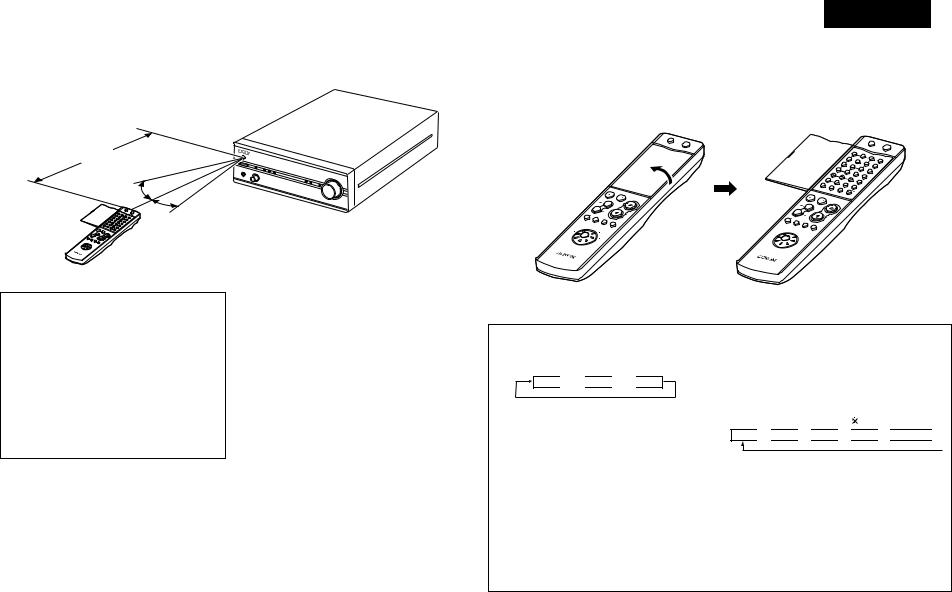
(2) Fernbedienungsbetrieb
Ca. 7 m
30°
30°
 + + --
+ + --
DEUTSCH
(3) Bezeichnung und Funktion der Fernbedienungstasten
2 Die Abdeckung der Fernbedienung öffnen
+ |
PRESET |
|
|
+ |
|
|
- |
|
|
|
|
- |
|
|
|
|
TAPE |
|
|
|
|
SLEEP |
F |
UNCTI ON |
|
|
|
|
MODE |
|
|
|
|
|
|
TUNER |
CD |
|
|
|
TAPE |
|
|
|
|
|
MD |
|
|
|
|
CD-R |
|
||
VOLUME /SELECT
OFF
SYSTEM |
ON |
|
|
|
STOP |
|
|
|
PRESET |
|
|
|
+ |
|
|
- |
+ |
|
|
|
|
|
|
- |
|
|
|
TAPE |
|
|
|
SLEEP |
FUNC ITON |
|
|
|
MODE |
|
|
|
|
|
TUNER |
CD |
|
|
TAPE |
|
|
|
|
|
MD |
|
|
|
|
|
|
OFF |
|
|
|
|
|
|
SYS |
ON |
|
|
|
|
|
POWTEM |
|
|
|
|
|
|
ER |
|
|
|
|
1 |
|
|
|
|
|
|
2 |
|
|
|
|
|
4 |
55 |
3 |
D PIRERCOGT |
/ |
|
|
7 |
6 |
|
|
|
|
|
|
CALL |
|
||
|
|
|
8 |
|
|
|
+ |
|
9 |
CLEAR |
|
||
|
10 |
0 |
RANDOM |
|
||
CD- |
R |
CD |
REPEAT |
|
|
|
|
|
TAPSERS |
|
|
|
|
DOLBY |
|
|
MD |
|
|
|
|
MROEDE.V |
TIME EDIT |
|
|
||
RDS |
|
DIMMER |
TIME/ |
|
|
|
BAND |
|
|
PANEL |
|
|
|
|
|
TUNING |
|
|
|
|
|
|
PTY |
|
|
|
|
PLAY |
|
|
|
|
|
|
VOLU |
|
|
|
|
||
/SELECTME |
|
|
|
|
||
CD-R
REMOTE |
RC-906 |
|
|
|
CONTROL UNIT |
REMOTE |
RC-906 |
|
|
|
CONTROL UNIT |
HINWEISE:
•Der Betrieb des Fernbedienungsgerätes ist möglicherweise schwierig, wenn der Fernbedienungssensor direktem Sonnenlicht oder starkem künstlichem Licht ausgesetzt ist.
•Drücken Sie keine Tasten am Hauptgerät und auf dem Fernbedienungsgerät gleichzeitig, da dies in einer Fehlfunktion resultieren würde.
•Neonschilder oder andere sich in der Nähe befindliche impulsartige Störungen ausstrahlende Geräte können Fehlfunktionen verursachen. Halten Sie die Anlage soweit wie möglich von derartigen Einrichtungen fern.
•Richten Sie das Fernbedienungsgerät - wie im Diagramm gezeigt - auf den Fernbedienungssensor am Hauptgerät.
•Die Reichweite des Fernbedienungsgerätes beträgt aus gerader Entfernung vom Hauptgerät ca. 7 Meter. Diese Entfernung verkürzt sich jedoch, wenn Gegenstände im Weg liegen oder das Fernbedienungsgerät nicht direkt auf den Fernbedienungssensor gerichtet wird.
•Das Fernbedienungsgerät kann in einem horizontalen Winkel von bis zu 30 Grad zum Fernbedienungssensor betrieben werden.
RDS-Taste
Stimmen Sie mit dieser Taste automatisch Sender ab,
die das Radiodatensystem verwenden.
RDS 
 PTY
PTY 
 TP
TP
Drücken Sie nach der Wahl von “PTY” mit der RDSTaste die Taste PRESET < oder >, um eine der 29 Programmsparten auszuwählen
PANEL-Taste
Mit dieser Taste wird der Feld-Betrieb ausgewählt.
Drücken Sie diese Taste, wenn RDS-Sender empfangen werden, um die Frequenz, PS, PTY, RT oder CT-Display auszuwählen.
Der Display-Betrieb wird bei jeder Tastenbetätigung wie folgt geändert.
PS 
 PTY
PTY 
 RT
RT 

 CT
CT 
 Frequency
Frequency 


 CT-Display
CT-Display
Wählen Sie das Display, um die Uhrzeit am DRA201SA zu korrigieren. Drücken Sie die PANEL-Taste, wenn der Uhrzeit-Service eines RDS-Senders einwandfrei empfangen wird. “CT” und “TIME” werden angezeigt und die Uhrzeit des DRA-201SA wird korrigiert. “NO CT” wird angezeigt, wenn ein RDS-Sender kein Uhrzeit-Service anbietet und wenn die Übertragung nicht einwandfrei empfangen wird.
Beachten Sie, dass diese Taste bei schlechtem Empfang nicht funktioniert.
27

DEUTSCH
Zahlentasten
Mit diesen Tasten stellen Sie gespeicherte Sender ein.
Beispiele:
Den Sender unter der Voreinstellnummer 12 speichern:
Drücken Sie +10 , 2 Den Sender unter der
Voreinstellnummer 29 speichern: Drücken Sie +10 , +10 , 9
RDS-Taste (RDS)
BAND-Taste (BAND)
Wählen Sie mit dieser Taste den Frequenzbereich aus.
 FM AUTO FM MONO AM
FM AUTO FM MONO AM 
Taste PRESET (PRESET)
Mit diesen Tasten rufen Sie im Tuner gespeicherte Sender ab. Wenn Sie “PTY” mit der RDSTaste ausgewählt haben, können Sie mit dieser Taste einen der 29 Programmtypen auswählen.
SLEEP-Taste (SLEEP)
Zum Einstellen des Sleep-Timers.
2Tasten, die hier nicht beschrieben sind, haben die gleiche Funktion wie die entsprechenden Tasten auf der Fernbedienung der Haupteinheit.
Bereitschaftsbetriebstaste
(SYSTEM POWER STANDBY)
Drücken Sie diese Taste, um die Stromversorgung des DRA-201SA in Bereitschaft zu schalten.
(Bei Anschluss an ein System der 201SA-Serie schaltet diese Taste die Stromversorgung des gesamten Systems in Bereitschaft.)
Funktionsbedienungsblock
der 201SA-Serie
Bei einem Anschluss an ein System der 201SA-Serie, werden mit diesen Tasten die angeschlossenen Systemkomponenten bedient.
Beziehen Sie sich hinsichtlich der Bedienungsanweisungen auf die Handbücher der verschiedenen Komponenten.
FUNCTION-Taste
Drücken Sie diese Taste, um die Funktionsquelle auszuwählen, die abgespielt werden soll.
Die Funktion wechselt bei jeder Tastenbetätigung in der folgenden Reihenfolge:
CD |
|
TUNER |
DVD/AUX |
MD |
TAPE |
AUX-2 |
PHONO |
Funktionswahlschalter auf der Fernbedienung
Wählen Sie mit diesem Schalter die Funktion aus, die mit der Fernbedienung bedient werden soll. Beziehen Sie sich hinsichtlich der Bedienung der verschiedenen Komponenten auf die jeweiligen Handbücher.
Netztaste
(SYSTEM POWER ON)
OFF |
|
|
ON |
|
|
|
SYSTEM |
|
|
||
|
POWER |
|
|
||
|
|
|
|
|
PROG / |
|
|
|
|
|
DIRECT |
1 |
2 |
|
3 |
|
|
|
|
|
|
|
CALL |
4 |
5 |
|
6 |
|
|
|
|
|
|
|
CLEAR |
7 |
8 |
|
9 |
|
|
|
|
RANDOM |
REPEAT |
||
10 |
+10 |
|
|
|
|
|
CD SRS |
|
TIME EDIT |
||
CD-R |
TAPE |
|
MD |
||
Dolby NR |
REV. |
DIMMER |
TIME/ |
||
MODE |
PANEL |
||||
RDS |
BAND |
|
TUNING |
||
STOP |
PLAY |
|
VOLUME |
||
|
|
|
|
/SELECT |
|
PRESET |
|
|
|
|
|
|
+ |
|
|
|
|
- |
|
|
|
|
|
TAPE |
SLEEP FUNCTION |
MODE |
|||
|
|||||
|
|
CD |
|
|
|
TUNER |
|
|
|
|
MD |
TAPE |
CD-R |
RC-906
REMOTE CONTROL UNIT
Wenn diese Taste gedrückt wird, während die Stromversorgung des DRA-201SA in Bereitschaft geschaltet ist, wird der DRA201SA eingeschaltet.
(Bei Anschluss an ein System der 201SA-Serie schaltet diese Taste die Stromversorgung des gesamten Systems ein.)
DIMMER-Taste
Mit Hilfe dieser Funktion können Sie die Helligkeit des Displays verändern. Die Display-Helligkeit ändert sich bei mehrfacher Betätigung der DIMMER-Taste auf dem Fernbedienungsgerät in vier Schritten (hell, mittel, gedimmt, aus).
VOLUME/SELECT-Tasten
•Drücken Sie D, um die Lautstärke zu erhöhen; drücken Sie H, um sie zu senken.
•Mit diesen Tasten werden auch die verschiedenen Betriebsarten eingestellt.
MODE-Taste
Modelle, die mit der Systemfernbedienung kompatibel sind
• Receiver |
: |
DRA-201SA |
• CD-Player |
: |
DCD-201SA |
• Cassetten Deck |
: |
DRR-201SA |
• MD-Recorder |
: |
DMD-201SA |
Die oben stehenden Tasten ohne Erklärung können nicht beim DRA-201SA verwendet werden.
PANEL-Taste (PANEL)
Tasten TUNING (•,ª)
Wählen Sie mit diesen Tasten den Sender aus.
28

7 BETRIEB
(1) Wiedergabe
VOLUME
|
|
BAND |
MEMORY |
PRESET / TUNING |
SOURCE DIRECT |
|
ON / STANDBY |
MODE |
TIMER / RDS |
/ SET |
DOWN |
UP |
|
PHONES |
FUNCTION |
|
|
|
|
|
|
|
|
MHz |
|
|
CH |
TUNED STEREO AUTO
STEREO RECEIVERER DRA-201SA
2 |
3 |
|
|
7 |
5 |
|
|
OFF |
ON |
2 |
|
|
|
SYSTEM |
|
|
|
|
|
POWER |
|
|
|
|
|
|
|
|
|
|
|
|
PTY |
|
|
|
|
|
|
PROG / |
|
|
|
|
|
DIRECT |
|
|
1 |
2 |
3 |
|
|
|
STOP |
PLAY |
VOLUME |
|
|
|
|
|
/SELECT |
|
|
|
PRESET |
|
|
|
|
|
|
+ |
|
|
|
|
- |
|
|
5 |
|
|
TAPE |
SLEEP FUNCTION |
MODE |
|
|
|
|
|
|||
|
|
CD |
|
3 |
|
|
TUNER |
|
MD |
|
|
1 |
Überprüfen Sie, ob alle Verbindungen richtig |
sind. |
Schalten Sie das Gerät ein.
•Diese Anzeige blinkt zunächst rot, dann grün und hört dann auf zu blinken (bleibt erleuchtet).
ON
ON / STANDBY
SYSTEM
POWER
|
(Haupteinheit) |
(Fernbedienung) |
2 |
2 Stromversorgungs-/Bereitschaftsbetrieb und |
|
Funktionsspeicher |
|
|
BWenn bei aktiviertem Bereitschaftsbetrieb die Stromversorgung des DRA-201SA mit der Systemfernbedienung eingeschaltet wird, wird die Funktion eingestellt, die eingestellt war als die Stromversorgung in Bereitschaft geschaltet wurde. (Letzte Speicherfunktion)
BWenn die Funktion aus dem Speicher gelöscht wurde, wird die Funktion bei Einschalten der Stromversorgung des DRA-201SA auf “CD” gestellt.
Drehen Sie entweder den FUNCTION-Wähler auf der Haupteinheit oder drücken Sie die FUNCTION-Taste auf der Fernbedienung, um die Funktionsquelle auszuwählen, die abgespielt werden soll.
• Die Funktion wechselt in der unten angezeigten Reihenfolge.
Die Funktion wechselt in der umgekehrten Reihenfolge, wenn der Wähler gegen den Uhrzeigersinn (.) gedreht wird.
3 |
FUNCTION |
FUNCTION |
|
|
(Haupteinheit) |
(Fernbedienung) |
|
|
|
CD |
TUNER |
|
MD |
TAPE |
AUX-2 |
Starten Sie die Wiedergabe von der angewählten Komponente.
4 • Einzelheiten zum Betrieb entnehmen Sie bitte der Betriebsanleitung der entsprechenden Komponente.
Stellen Sie die Lautstärke ein.
|
VOLUME |
|
/SELECT |
VOLUME |
|
5 |
|
(Haupteinheit) |
(Fernbedienung) |
Justieren Sie die BALANCE-, BASSund TREBLE-Regler und stellen Sie die LOUDNESSRegler auf die gewünschte Position.
6 Anleitungen hierzu finden Sie im Abschnitt “(3) Einstellung der verschiedenen Betriebsarten” auf seite 29, 30.
Verwendung der Quellen-Direktfunktion:
Stellen Sie die SOURCE DIRECT-Taste auf die Position “ON”.
7 |
SOURCE DIRECT |
(Haupteinheit)
(2) Aufnahme
1 |
Folgen Sie den Schritten 1 bis 4 unter “(1) |
||
Wiedergabe”. |
|
|
|
|
|
||
|
Starten Sie die Aufnahme mit dem |
||
|
Kassettendeck oder dem MD-Recorder. |
||
|
Lesen Sie sich hinsichtlich der Anleitung die |
||
|
Bedienungsanleitung der |
jeweiligen |
|
|
Komponenten durch. |
|
|
|
• Das Bedienen der Steuerungen VOLUME, |
||
|
BALANCE, BASS, TREBLE sowie LOUDNESS |
||
2 |
hat keinerlei Auswirkungen auf den |
||
aufzunehmenden Klang. |
|
||
|
• Wenn die Funktionsquelle auf “MD” |
||
|
eingestellt ist, wird die Aufnahme vom MD- |
||
|
Recorder zum Kassettendeck durchgeführt. |
||
|
Wenn die Funktionsquelle auf “TAPE” |
||
|
eingestellt ist, wird die Aufnahme vom |
||
|
Kassettendeck |
zum |
MD-Recorder |
|
durchgeführt. |
|
|
|
|
|
|
DEUTSCH
(3)Einstellen der verschiedenen Betriebsarten
VOLUME
|
|
BAND |
MEMORY |
|
PRESET / TUNING |
SOURCE DIRECT |
ON / STANDBY |
MODE |
TIMER / RDS |
/ SET |
|
DOWN UP |
|
PHONES |
FUNCTION |
|
|
|
|
|
|
|
|
|
MHz |
|
CH |
|
|
TUNED STEREO |
AUTO |
|
|
|
STEREO RECEIVERER DRA-201SA
2 |
1 |
|
|
STOP PLAY |
VOLUME |
|
|
/SELECT |
|
PRESET |
|
|
+ |
|
|
- |
2 |
TAPE
SLEEP FUNCTION MODE
1
[1] Einstellen des Loudness-Modus
Drücken Sie die MODE-Taste, um den Modus anzeigen zu lassen, der eingestellt werden soll (“BASS” oder “TREBLE”).
MODE MODE
(Haupteinheit) (Fernbedienung)
• Bei jeder Tastenbetätigung wird der Modus
1 |
wie folgt eingestellt: |
|
|
|
|
||||||||||
|
|
|
|
|
|
|
|
|
|
|
|
|
|
|
|
|
|
|
|
|
BASS |
|
|
TREBLE |
|
|
LOUDNESS |
|
|
||
|
|
|
|
|
|
|
|
|
|
|
|
|
|
||
|
|
|
|
Playback |
|
|
|
SPEAKER |
|
|
BALANCE |
|
|
||
|
|
|
|
|
|
|
|
|
|
|
|||||
|
|
|
|
|
|
|
|
|
|
|
|
|
|
||
|
|
|
function source |
|
|
|
|
|
|
|
|
||||
Wenn der Quellen-Direktbetrieb eingestellt ist, wechselt der Betrieb wie unten angezeigt (die BASSund TREBLE-Einstellmodi können nicht ausgewählt werden).
SPEAKER |
|
Playback function source |
|
||
|
|
|
Drehen Sie entweder den FUNCTION-Wähler auf der Haupteinheit oder verwenden Sie die SELECT-Tasten auf der Fernbedienung.
VOLUME
/SELECT
FUNCTION
2 (Haupteinheit) (Fernbedienung)
• Um die Höhen oder Tiefen zu erhöhen: Drehen Sie den Wähler im Uhrzeigersinn (,) oder drücken Sie die D-Taste.
Um die Höhen oder Tiefen zu verringern: Drehen Sie den Wähler gegen den Uhrzeigersinn (.) oder drücken Sie die H- Taste.
•Die Tiefen und Höhen können in 2er-Schritten zwischen –12 bis 0 bis auf +12 eingestellt werden. Der Frequenzgang ist bei 0 flach.
29
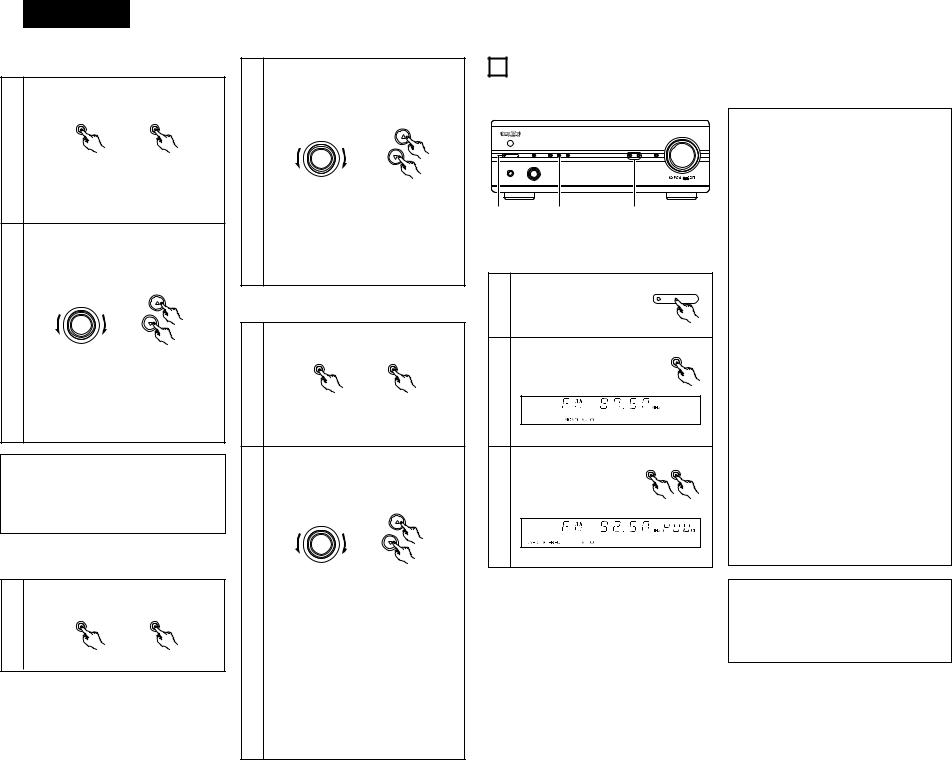
DEUTSCH
[2] Einstellen des Loudness-Modus
Drücken Sie die MODE-Taste, um “LOUDNESS” anzeigen zu lassen.
MODE |
MODE |
1
(Haupteinheit) (Fernbedienung)
•Der Modus wechselt bei jeder Tastenbetätigung wie links angezeigt.
“LOUDNESS” kann nicht eingestellt werden, wenn der Quellen-Direktbetrieb aktiviert ist.
Drehen Sie entweder den FUNCTION-Wähler auf der Haupteinheit oder verwenden Sie die SELECT-Tasten auf der Fernbedienung.
VOLUME
/SELECT
FUNCTION |
(ON) |
(OFF) |
(ON) |
2 |
(OFF) |
|
|
(Haupteinheit) |
(Fernbedienung) |
• Auf “ON” einstellen: |
|
Drehen Sie den Wähler im Uhrzeigersinn |
|
(,) oder drücken Sie die D-Taste. |
|
Auf “OFF” stellen: |
|
Drehen Sie den Wähler gegen den |
|
Uhrzeigersinn (.) oder drücken Sie die H- |
|
Taste. |
|
HINWEIS:
Die Tiefen, Höhen und Loundness können zusammen auf maximal +12 erhöht werden. Wenn die Tiefen und Höhen auf beispielsweise +12 eingestellt sind, ändert sich der Ton beim Einund Ausschalten der LoudnessFunktion nicht.
[3] Einstellen des Lautsprecherbetriebs
Drücken Sie die MODE-Taste, um “SPEAKER” anzeigen zu lassen. (Siehe seite 29.)
MODE |
MODE |
1
(Haupteinheit) (Fernbedienung)
Drehen Sie entweder den FUNCTION-Wähler auf der Haupteinheit oder verwenden Sie die SELECT-Tasten auf der Fernbedienung.
|
VOLUME |
|
/SELECT |
FUNCTION |
(ON) |
|
|
(OFF) |
(ON) |
2 |
(OFF) |
(Haupteinheit) |
(Fernbedienung) |
• Auf “ON” einstellen: |
|
Drehen Sie den Wähler im Uhrzeigersinn |
|
(,) oder drücken Sie die D-Taste. |
|
Auf “OFF” stellen: |
|
Drehen Sie den Wähler gegen den |
|
Uhrzeigersinn (.) oder drücken Sie die H- |
|
Taste. |
|
[4] Einstellen der Balance
Drücken Sie die MODE-Taste, um “BALANCE” anzeigen zu lassen. (Siehe seite 29.)
MODE |
MODE |
1
(Haupteinheit) (Fernbedienung)
“BALANCE” kann nicht eingestellt werden, wenn der Quellen-Direktbetrieb aktiviert ist.
Drehen Sie entweder den FUNCTION-Wähler auf der Haupteinheit oder verwenden Sie die SELECT-Tasten auf der Fernbedienung.
VOLUME
/SELECT
FUNCTION
|
(Haupteinheit) |
(Fernbedienung) |
||
|
• Wenn die Lautstärke des |
rechten |
||
2 |
Lautsprechers niedrig ist: |
|
|
|
Drehen Sie den Wähler im Uhrzeigersinn |
||||
|
||||
|
(,) oder drücken Sie die D-Taste. |
|
||
|
Wenn die Lautstärke des linken Lautsprechers |
|||
|
niedrig ist: |
|
|
|
|
Drehen Sie den Wähler gegen den |
|||
|
Uhrzeigersinn (.) oder drücken Sie die H- |
|||
|
Taste. |
|
|
|
|
• Die Balance kann auf “CENTER” gestellt oder |
|||
|
innerhalb eines Bereichs von +1 bis +10 in |
|||
|
1er-Schritten eingestellt werden. Wenn |
|||
|
“CENTER” eingestellt ist, |
ist der |
||
|
Lautstärkeunterschied zwischen dem linken |
|||
|
und rechten Lautsprecher gleich 0. |
|
||
8 RADIO HÖREN
(1) Abstimmung
VOLUME
|
|
BAND |
MEMORY |
|
PRESET / TUNING |
SOURCE DIRECT |
ON / STANDBY |
MODE |
TIMER / RDS |
/ SET |
|
DOWN UP |
|
PHONES |
FUNCTION |
|
|
|
|
|
|
|
|
|
MHz |
|
CH |
|
|
TUNED STEREO |
AUTO |
|
|
|
STEREO RECEIVERER DRA-201SA
1 2 3
Beispiel: Abstimmung eines UKW-Senders auf 92,50 MHz (Die Abstimmung von MW-Sendern erfolgt auf dieselbe Weise)
|
|
|
ON / STANDBY |
1 |
Netzschalter drücken, um das |
|
|
Gerät einzuschalten. |
|
|
|
|
Gerät durch Betätigung der |
BAND |
|
|
/ RDS |
||
|
|
|
|
|
UKW/MW- BAND/RDS-taste am |
|
|
|
Tuner auf UKW schalten. |
|
|
2 |
|
|
|
|
Frequenz mit Hilfe der |
PRESET / TUNING |
|
|
DOWN UP |
||
|
PRESET/TUNING |
|
|
|
UP/DOWM auf 92,50 MHz |
|
|
|
einstellen. |
|
|
3 Leuchtdisplay nach erfolgter Senderabstimmung
Die Funktion der Taste UP/DOWN am Hauptgerät kann zwischen modus TUNING UP/DOWN und PRESET UP/DOWN wechseln.
•Drücken Sie die MEMORY/SET-Taste für mindestens 3 Sekunden. Drücken Sie anschließend die UP-Taste.
Die Funktion der UP/DOWN-Tasten wechselt zu TUNING UP/DOWN.
•Drücken Sie die MEMORY/SET-Taste für mindestens 3 Sekunden. Drücken Sie danach die DOWN-Taste. Die Funktion der UP/DOWN-Tasten wechselt und PRESET UP/DOWN.
•Die Taste UP/DOWN ist werkseitig als Taste für den Taste TUNING UP/DOWN eingestellt. Vergewissern Sie sich jedoch, daß die Tasten UP/DOWN als Taste TUNING UP/DOWN fungieren, bevor Sie mit Schritt 3 fortfahren.
Automatische Sendersuche
•Empfängt das Gerät eine in Stereo ausgestrahlte Sendung, leuchtet die Meldung “STEREO” auf, und die Sendung wird in Stereo wiedergegeben.
•Bei schlechter Empfangsqualität und hohem Rauschanteil der Stereosignale empfiehlt es sich, durch Betätigung der BAND-Taste auf UKW MONO zu schalten.
•Bei Betätigung einer Abstimmtaste TUNING UP/DOWN wird die Frequenz im UKW-Band in Schritten von 50 kHz, im MW-Band in Schritten von 9 kHz weitergeschaltet.
•Wird eine der Tasten TUNING UP/DOWN länger als 1 Sekunde gehalten, so läuft der Sendersuchlauf nach dem Loslassen dieser Taste solange weiter, bis ein Sender erfaßt ist. Dabei werden jedoch nur Sender von einwandfreier Empfangsqualität berücksichtigt.
•Zur Deaktivierung der automatischen Sendersuche muß die Abstimmtaste TUNING UP/DOWN einmal kurz gedrückt werden.
HINWEIS:
Ist während des MW-Empfangs in unmittelbarer Nähe des Geräts ein Fernseher in Betrieb, kann die Wiedergabe durch Brummgeräusche gestört werden. Stellen Sie das Gerät in diesem Fall möglichst weit entfernt von diesem Fernseher auf.
30
